Cuisines of the steppe peoples
Printed From: History Community ~ All Empires
Category: Regional History or Period History
Forum Name: Steppe Nomads and Central Asia
Forum Discription: Nomads such as the Scythians, Huns, Turks & Mongols, and kingdoms of Central Asia
URL: http://www.allempires.com/forum/forum_posts.asp?TID=25325
Printed Date: 12-May-2024 at 15:49
Software Version: Web Wiz Forums 9.56a - http://www.webwizforums.com
Topic: Cuisines of the steppe peoples
Posted By: calvo
Subject: Cuisines of the steppe peoples
Date Posted: 01-Sep-2008 at 16:53
|
Could anyone give a brief summary of the typical cuisines and eating habits of the following steppe peoples:
- Kazakhs
- Uighurs
- Mongols (from Mongolia)
- Uzbeks
- Turkmens
- Kirgiz
- Kazan Tatars
- Crimean Tatars
- Bashkirs
I have the impression that their diet is very meat-based with an abundancy in lamb and beef. But how are the dishes made?
Does Anatolian Turkish cuisines have anything to do with their heritage from the steppes, or is is mostly from the subject peoples of the eastern Mediterranean?
|
Replies:
Posted By: Bulldog
Date Posted: 01-Sep-2008 at 17:27
Calvo
Could anyone give a brief summary of the typical cuisines and eating habits of the following steppe peoples:
- Kazakhs
- Uighurs
- Mongols (from Mongolia)
- Uzbeks
- Turkmens
- Kirgiz
- Kazan Tatars
- Crimean Tatars
- Bashkirs
I have the impression that their diet is very meat-based with an abundancy in lamb and beef. But how are the dishes made? |
Common dishes for the Turkic peoples listed (I'm not including Mongols, I don't have knowledge of their cuisine)
- Dolmas, literally means 'to be stuffed', common dolmas are vineleaf stuffed with rice and other ingrediants, stuffed peppers and other vegetables there are many variations and styles.
- Boreks, a type of pastry or pie made from yufka which is thin flaky dough, there are hundreds of variations and styles, Tatars/Nogays have many famous boreks aswell.
- Chorek, similar to boreks, a flat bread/pastry type dish popular among many Turkic peoples. Break in general is very important in Turkic cuisines, every meal is accompanied with bread.
- Kebab/Shashlik, I think everybody knows what these are.
- Pilafs/Plov, these are rice dishes, everybody claims to have the best pilaf dish but most accept Ozbek Pilaf to be among the best.
- Chorba/Shurva, these are soups, popular as starters and during breakfast.
- Manti, dumpling type dish with many styles and variaties.
- Baklava, the well known dessert type foods
- Typical beverages, Chay (Tea), Ayran a yoghurt drink, Keffir and Gatyk another dairy type drink, Kimiz and so on.
The list could go on and on, however, an important point is to correct the misconception that these Turkic cuisines are predominantly meat based. Fruit and vegetables are an important part of the diet aswell, melons, watermelons, grapes, apricots, auborgines, pommegrantes etc etc are used alot.
| Calvo
Does Anatolian Turkish cuisines have anything to do with their heritage from the steppes, or is is mostly from the subject peoples of the eastern Mediterranean? |
Anatolian Turkish cuisine is closely connected to other Turkic cuisines, the backbone of this cuisine is based upon the foods I listed above. Dolmas, Boreks, Kebabs, Corbas, Yoghurt dishes, Breads etc etc are essential parts of the cuisine, however, what made Anatolian Turkish cusine so rich is incorporating other ingrediants, foods and cooking styles into their already extensive kitchen. For example, due to geographical regions Central Asia does not have a rich sea food cusine, however, Anatolian Turkish has and this is mainly due to borrowing from the Greeks. The Turkic cuisine was kept and built upon by the Turks of Anatolia.
-------------
�What we do for ourselves dies with us. What we do for others and the world remains and is immortal.�
Albert Pine
|
Posted By: xi_tujue
Date Posted: 01-Sep-2008 at 19:02
Tutmaç is my favourite dish of Central Asia
It's Yoghurt Noodle soup with lots of herbs mostly black pepper.
Eventhough in Turkey the Noodles are shorter than the orginal
eventhough it's a 'soup' after 2 plates you'll be full
Traditional dishes from Ahiska are my favourite it's basicly 90% pastry
Xinkal aka Manti (The caucasus has probably the most types of Dumplings)
Xaçapur: thick yufka like dough filled with minced meat, cheese, spinace, pattaoes, etc.. folded in half and baked on a sac
Kete: Like çörek only thicker and more greasy
Tutmaç is mabey strictly eaten in North Western Turkey in Turkey I mean
why is the Turkish cuisine one of the three best cuisines in the world and the greek not basicly due to the Central Asian heritage wich was allready 'experimented' with when they moved further west to Persia and the ME.
Most dishes claimed by the Balkan countries and I hate to say it esspecialy greece where developed in teh Ottoman Empire and hence are not from the Balkan. The fact is there names only make sense in Turkish
Dolma : something that is filled
Sarma: something that is rolled (eventhough grapeleaves are used teh orginal sarmas where made of cabbadge)
-------------
I rather be a nomadic barbarian than a sedentary savage
|
Posted By: calvo
Date Posted: 02-Sep-2008 at 07:32
|
Thanks for the info.
I'm surprised that Turkic peoples of Central Asia actually ate a large amount of pastry and even rice dishes. They had to import to wheat as many of the peoples were exclusively cattle herders. And rice? I thought that rice needs a large quantity of water to be cultivated. Where in Central Asia could there be paddy fields?
Another question: there are 2 Turkic peoples who are living relatively close to each other geographically: the Kazan Tatars and the Kazakhs. One has been sedentary for many centuries, and the other remained nomadic herdsmen and plunderers well into the 20th century. Are their national dishes similar?
|
Posted By: Sarmat
Date Posted: 02-Sep-2008 at 13:40
|
The most popular food of the steppe people is meat, meat and meat again.
Uzbek cuisine in many instances is not really nomadic. Rice has been cultivated in the sedentary Central Asia for milleniums as well as tea, silk and cotton during the later times.
So, Koreans didn't have a lot of problem of applying their skills of rice cultivation when they were moved there by Stalin.
-------------
Σαυρομάτης

|
Posted By: xi_tujue
Date Posted: 02-Sep-2008 at 13:45
well meat dishes are a given aren't they
my dad allways says it's not a dish untill there is meat in it if not it's a side dish
-------------
I rather be a nomadic barbarian than a sedentary savage
|
Posted By: calvo
Date Posted: 03-Sep-2008 at 13:14
|
How do people eat on the steppes?
Do you they fork and knife or just with their hands?
|
Posted By: xi_tujue
Date Posted: 03-Sep-2008 at 13:17
with a SPOON i think they used to eat everything with a spoon except meat ofc
-------------
I rather be a nomadic barbarian than a sedentary savage
|
Posted By: Sarmat
Date Posted: 03-Sep-2008 at 13:23
Originally posted by calvo
How do people eat on the steppes?
Do you they fork and knife or just with their hands? |
Traditionally yes, with hands and knife only. Actually even in Uzbekistan the traditional way to eat pilaf is with your own hands.  ------------- Σαυρομάτης

|
Posted By: xi_tujue
Date Posted: 03-Sep-2008 at 13:50
^strange I thought they used wooden spoons
-------------
I rather be a nomadic barbarian than a sedentary savage
|
Posted By: Sarmat
Date Posted: 03-Sep-2008 at 14:05
Genghiz khan family meal from a Russian commercial. 
Pay attention to how they eat.
http://www.youtube.com/watch?v=s7cR5QpKb3E&feature=related - http://www.youtube.com/watch?v=s7cR5QpKb3E&feature=related
-------------
Σαυρομάτης

|
Posted By: xi_tujue
Date Posted: 03-Sep-2008 at 14:17
they where eating meat i said besides meat
-------------
I rather be a nomadic barbarian than a sedentary savage
|
Posted By: Sarmat
Date Posted: 03-Sep-2008 at 14:30
|
Yes, I got it. But traditionally steppe people didn't use spoons. But the purpose of the video wasn't to prove that it just was a side illustration. 
-------------
Σαυρομάτης

|
Posted By: Bulldog
Date Posted: 03-Sep-2008 at 14:43
|
Steppe peoples used spoons, it was necessary for soups and dishes cooked in big couldrons called Qazans.
-------------
�What we do for ourselves dies with us. What we do for others and the world remains and is immortal.�
Albert Pine
|
Posted By: Sarmat
Date Posted: 03-Sep-2008 at 15:13
They probably used some some tools to cook the food in big kazans, but they didn't use spoons while eating. The soup was eaten from the small bow without the use of spoon.
-------------
Σαυρομάτης

|
Posted By: Bulldog
Date Posted: 03-Sep-2008 at 15:32
|
By steppe people do you mean just nomadic?
Kashik/Gashik/Kashok are and have been used among Turkic peoples. However, the traditional way of eating is on a low table, sitting on the floor, a washing bowl is passed around and water is poured on those who will eat hands also cologne can be used. Then the eating can begin, traditionally hands and knife were used, spoons on some occasions, most meals are accompanied with bread.
-------------
�What we do for ourselves dies with us. What we do for others and the world remains and is immortal.�
Albert Pine
|
Posted By: Afghanan
Date Posted: 03-Sep-2008 at 19:35
Originally posted by Bulldog
By steppe people do you mean just nomadic?
Kashik/Gashik/Kashok are and have been used among Turkic peoples. However, the traditional way of eating is on a low table, sitting on the floor, a washing bowl is passed around and water is poured on those who will eat hands also cologne can be used. Then the eating can begin, traditionally hands and knife were used, spoons on some occasions, most meals are accompanied with bread. |
This is what they do in Afghanistan as well. Rice dishes are eaten by hand, and there is plenty of finger foods. Aash (soups) is eaten with Kashuk (wooden spoons) except there is no low table, but people normally eat on a destarkhan (a long rectangular mat/sheet placed on the ground).
-------------
The perceptive man is he who knows about himself, for in self-knowledge and insight lays knowledge of the holiest.
~ Khushal Khan Khattak
|
Posted By: gok_toruk
Date Posted: 04-Sep-2008 at 17:14
|
For sure, "meat" is the core part of Central Asian cuisine, and not pastry. Just some points about the names (regarding cusines):
Kebab is "Shara". Also, "Shishlyk" (and not "Shashlyq) is different from "Shara". While "Shara" is "barbecue" (in fact, it means "to barbecue"), "Shish" is a kind of meat (I don't remember the Engilsh word now, sorry).
"Pilav" is a Persian word - not Turkic; but almost everyone in Turkey uses this word. Regarding rice dishes, we have 2 differnet ways to make the dish:
1- Süzme (which is what Bulldog explained, about the word "Pilov")
2- Chektyrme (which is most famous among Turkmens).
And, "Chorba" is not soup exactly. You may find, anyhow, soup's ingredients, but "Chorba" is "Chorba", "Soup" is "Soup".
And of beverages, you forgot to mention "Küremez" (of goat milk) and "Tüye Chal" (Camel's milk).
I will write more soon.
-------------
Sajaja bramani totari ta, raitata raitata, radu ridu raitata, rota.
|
Posted By: gok_toruk
Date Posted: 05-Sep-2008 at 12:31
|
I don't agree about the idea "Central Asia does not have a rich sea food cuisine". You can find different dishes (of fish) among Turkmens and Kazaks.
And, Turkish culture has preserved Central Asian cuisine, TO SOME EXTENT. Although you might observe Kebab or Dolma in Turkey, but still, there's a lot more, such as Qatlama, Ekmek (which is differrent from Turkish word, for "bread", "Ekmek"), Pyshme, Qawurtmach, Talqan, etc that are made only in Central Asia.
We had/have "Qashyq" which is nowadays used to refer to a "spoon", but the old "Qashyq"s were not like the present days samples (in fact, "Qashyq" doesn't mean "spoon"). Old (nomadic) Turks didn't use "Qashyq".
Anyhow, even today, lots of people, use their hands only - not spoons - to eat. Foreigners always marvel to see people here eating with their hands.
I haven't seen anyone, here, eating on a low table - that seems Chinese. We sit on the ground, around "Sachaq" (table cloth - or ground cloth, should I say!).
-------------
Sajaja bramani totari ta, raitata raitata, radu ridu raitata, rota.
|
Posted By: Bulldog
Date Posted: 06-Sep-2008 at 00:41
| Gok_Toruk
I don't agree about the idea "Central Asia does not have a rich sea food cuisine". You can find different dishes (of fish) among Turkmens and Kazaks. |
There are fish dishes, mainly fresh water, infact some Central Asian access to the best caviar so your correct there is a rich water-food cuisine. However, as there is no seas with ocean access there was not as much focus on sea foods.
Gok_Toruk
And, Turkish culture has preserved Central Asian cuisine, TO SOME EXTENT. Although you might observe Kebab or Dolma in Turkey, but still, there's a lot more, such as Qatlama, Ekmek (which is differrent from Turkish word, for "bread", "Ekmek"), Pyshme, Qawurtmach, Talqan, etc that are made only in Central Asia. |
Qatlama is found in Azerbaycan, Turkey, Tatarstan etc although Turkmen wedding Katlama is special
Pyshme (fried dough) I've had this in many people from Turkey's homes they call it Pishi.
Its possible to find so many Central Asian dishes in Turkey depending on where you visit, different regions kept different dishes, even from village to village different dishes can be found.
-------------
�What we do for ourselves dies with us. What we do for others and the world remains and is immortal.�
Albert Pine
|
Posted By: Afghanan
Date Posted: 06-Sep-2008 at 01:05
Actually the Saka (Scythians) specialized in sea foods and rich fish sauces. I will try to find the references (I believe it was Herodotus who devulged on their dietary habits).
-------------
The perceptive man is he who knows about himself, for in self-knowledge and insight lays knowledge of the holiest.
~ Khushal Khan Khattak
|
Posted By: gok_toruk
Date Posted: 06-Sep-2008 at 10:38
|
Please; we're not talking about names. The Turkmen word "Ekmek" exists in Turkish too, but they refer to two different things. Could you please tell me about Turkish and Azeri Katlama? "Pyshme" is not "fried dough". If "fried dough" is the definition for "Pyshme", Iranians make this too. What's more, "Börek" is also a "fried dough" then. Do you have any picture of Turkish "Pishi", please?
Anyhow, what does "Pishi" mean in Turkish? I just wonder, since it's not from the same root "Pyshme" comes from - if you mean a similarity in name.
-------------
Sajaja bramani totari ta, raitata raitata, radu ridu raitata, rota.
|
Posted By: Sarmat
Date Posted: 06-Sep-2008 at 16:06
Originally posted by Afghanan
Actually the Saka (Scythians) specialized in sea foods and rich fish sauces. I will try to find the references (I believe it was Herodotus who devulged on their dietary habits). |
It would be great if you could provide a source for that. I thought that fish would the leat "prestigious" food for ancient nomades. At least I know that eating fish for Mongols meant to reach the "lowest level of poverty" meaning poor nomades don't have any horses and cattle so they are forced to catch and eat fish.
-------------
Σαυρομάτης

|
Posted By: xi_tujue
Date Posted: 06-Sep-2008 at 16:52
Originally posted by gok_toruk
Please; we're not talking about names. The Turkmen word "Ekmek" exists in Turkish too, but they refer to two different things. Could you please tell me about Turkish and Azeri Katlama? "Pyshme" is not "fried dough". If "fried dough" is the definition for "Pyshme", Iranians make this too. What's more, "Börek" is also a "fried dough" then. Do you have any picture of Turkish "Pishi", please? Anyhow, what does "Pishi" mean in Turkish? I just wonder, since it's not from the same root "Pyshme" comes from - if you mean a similarity in name.
|
In modernday Turkish they say Bishi

In modernday Turkish Ekmek is used to describe bread wether it be Yufka, pide, lavash or just slised bread
-------------
I rather be a nomadic barbarian than a sedentary savage
|
Posted By: gok_toruk
Date Posted: 09-Sep-2008 at 16:40
|
Sorry for this late reply. Thanks xi_tuje for the picture and explanation. The picture you posted here - Turkish "Bishi" - is called "Qoqun" in Turkmen - and it's different from "Pyshme". That was something new to me, thanks.
-------------
Sajaja bramani totari ta, raitata raitata, radu ridu raitata, rota.
|
Posted By: xi_tujue
Date Posted: 09-Sep-2008 at 18:51
^yeah
my grandmother calls it Loqum wich is Turkish delight in modernnTurkish
what does Pyshme look like?
-------------
I rather be a nomadic barbarian than a sedentary savage
|
Posted By: gok_toruk
Date Posted: 10-Sep-2008 at 12:09
I'll take a picture soon, next time when my mother cooks it. I need a place (online storage) to upload it since AE regulates a limit on size of pictures one posts, I suppose.
-------------
Sajaja bramani totari ta, raitata raitata, radu ridu raitata, rota.
|
Posted By: TugZy
Date Posted: 01-Nov-2008 at 10:38
|
You have a knife, u have your meal. Its the most necessary tool and it is not unusual to eat only with a knife in mongolia. do u think that someone will carry all these kitchen tools during long time journeys on horseback? This type of life is what we call nomadic.
|
Posted By: xi_tujue
Date Posted: 01-Nov-2008 at 13:08
Nomads aren't gypsies who are allways on the road they had pastures they didn't move daily or weekly only when needed like change of season or war. So they had quite a few belongings
-------------
I rather be a nomadic barbarian than a sedentary savage
|
Posted By: MythTR
Date Posted: 15-Mar-2009 at 21:39
|
Doner ? have you ever eat ? I like it very very much ! I CAN EAT IT ALL THE TIME (:
Delicious...
and Kebaps ... great.
-------------
We Turks are a people who throughout our history have been the very embodiment of freedom&independence
Mustafa Kemal ATATURK

|
Posted By: HungryWolf
Date Posted: 15-Mar-2009 at 22:03

Lule Kabap Turkic national eatings. All turkic peoples eat kabaps :)
-------------
http://img15.imageshack.us/my.php?image=nnna.gif">
Turks can be killed but can't be beaten. (Napoleon Bonaparte)
|
Posted By: HungryWolf
Date Posted: 15-Mar-2009 at 22:08
|
Turkish Anadolu Dolma :
Azerbaijani Caucasus Dolma :
there is little differences but both are very delicious :)
-------------
http://img15.imageshack.us/my.php?image=nnna.gif">
Turks can be killed but can't be beaten. (Napoleon Bonaparte)
|
Posted By: Bulldog
Date Posted: 15-Mar-2009 at 22:34
There is Dolma is Sherqi Turkistan and Ozbekistan aswell 
-------------
�What we do for ourselves dies with us. What we do for others and the world remains and is immortal.�
Albert Pine
|
Posted By: MythTR
Date Posted: 16-Mar-2009 at 17:26
Hungrywolf my brother, you made me hungry with your pictures (:
-------------
We Turks are a people who throughout our history have been the very embodiment of freedom&independence
Mustafa Kemal ATATURK

|
Posted By: HungryWolf
Date Posted: 16-Mar-2009 at 20:33
| Hungrywolf my brother, you made me hungry with your pictures (: |
;)
-------------
http://img15.imageshack.us/my.php?image=nnna.gif">
Turks can be killed but can't be beaten. (Napoleon Bonaparte)
|
Posted By: kukaracha
Date Posted: 30-Apr-2010 at 09:49
|
uzbek
http://www.youtube.com/watch?v=ORtP0k2nxoo
|
Posted By: Don Quixote
Date Posted: 14-Mar-2012 at 14:32
Here a Kazakh recipe which I would like to try when I get into coking inspiration:
"...
Gutap - Kazakh Deep-Fried Herb Fritters ingredients
- ---FILLING---
- 3 T dill freshly chopped fine
- 3 T parsley freshly chopped fine
- 1 T garlic, minced
- 9 T Scallions chopped fine
- 1 T Black pepper, freshly ground
- 8 T butter
- 1 1⁄2 t Salt
- ---DOUGH---
- 1 1⁄2 c All-purpose flour
- 1⁄2 t Salt
- 4 T butter, softened
- 2⁄3 c Luke warm water
- --Sauce--
- 1 t Cider vinegar
- 1⁄4 c Sour cream
- 2 T butter
- 1⁄2 t flour
- 6 T Finely minced onion
- 1⁄2 t Salt
- 1 t Black pepper, freshly ground
- 1 T Lemon or lime juice frshly squeezed & strained
Cooking Gutap - Kazakh Deep-Fried Herb Fritters
1. Place the flour into a deep mixing bowl.
2. Make a hollow in the center.
3. Add the water into the hollow, salt, & 2 T of the butter.
4. Stir http://www.cookadvice.com/food_dictionary/stir-4219.htm - i slowly untilk all of the ingredients are well mixed and the water is totally absorbed.
5. Beat vigorously with a large spoon until a firm, stiff dough is formed.
6. Gather the dough into a ball.
7. on floured surface roll the dough ball out into a rectangle approx.
8. 16" x 18". Brush the dough with the remaining butter, fold into quarters, then roll it out as thinly as possible.
9. Cut into a 16" x 18" rectangle the cut that into 48 each 2" squares.
10. FILLING: Combine the salt, pepper, scallions, garlic, parsley, & dill.
11. Cut the butter into tiny bits and chill until the dough is ready.
12. Place a teaspoon of the filling mix into the center of each square, add a piece of the butter to each.
13. Draw up the corners and pinch them together firmly thus closing the filling into the dough.
14. Heat enough oil in a deep pot. Heat to 375 degrees F. and drop in 4-6 of the filled squares.
15. Cook for 4 minutes, remove from the oil, drain, and serve warm.
16. SAUCE: Melt the butter, add the chopped onions, the salt, the pepper, & the vinegar.
17. Cook for 4 minutes then add the remaining ingredients.
18. Stir constantly until it thickens.
19. Remove from the heat.
20. Ad the lemon juice and serve over the fritters...." http://www.cookadvice.com/recipes/gutap__kazakh_deepfried_herb_fritters-1466-recipe.htm - http://www.cookadvice.com/recipes/gutap__kazakh_deepfried_herb_fritters-1466-recipe.htm
-------------
|
Posted By: Nick1986
Date Posted: 14-Mar-2012 at 19:24
The Mongols supposedly ate beef tenderised by keeping it under the saddle all day as they didn't have time to stop and cook it. Rather than raw meat, perhaps this was actually a type of jerky?
-------------
Me Grimlock not nice Dino! Me bash brains!
|
Posted By: TheAlaniDragonRising
Date Posted: 15-Mar-2012 at 00:39
|
Some examples of Uzbek national cuisine:
Sutli non - Flat bread
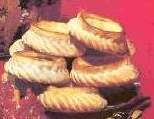 1 kg or 7 1/2 cups flour, 30 g (1 oz) yeast, 1-2 cups milk, 3 tablespoons oil, salt. 1 kg or 7 1/2 cups flour, 30 g (1 oz) yeast, 1-2 cups milk, 3 tablespoons oil, salt.
Dilute yeast in warm milk. mix in little sifted flour and oil. Add the rest of the flour and salted water as necessary. Knead dough and let stnad covered in warm place. Divide dough into 150-200g (5-7 oz) pieces and roll into balls. Flatten into round bread, 2 cm (3/4 in) at edges and 1 cm (2/5 in) in the center. Make a pattern in the center with a chekish. Sprinkle water on the underside and bake in a tandoor or an oven.

Obi-non - Flat bread
1 kg or 7 1/2 cups flour, 2 cups water, 2 teaspoons salt, 40 g (1 1/2 oz) yeast
Prepare dough as in flat bread recipe above. Divide dough into 150-200 g (5-7 oz.) pieces and roll into balls. Flatten into round bread, 2-3 cm (3/4-1 in) at adges and 5 mm (3/16 in.) in the center. Make a pattern in the center with a chekish. Sprinkle water on the underside and bake in a tandoor.

Jizzali non - Flat bread with fat
1 kg or 7 1/2 cups flour, 2 cups water, 2 teaspoons salt, 40 g (1 1/2 oz.) yeast, 1 cup cubed animal fat.
Fry fat, drain, and cool. Prepare dough as in flat bread recipe above owrking in pieces of fat evenly throughout the dough. Divide dough into 40 g (1 1/2 oz) pieces and roll into balls. Continue with Obi-non recipe from above.

Kunjutli va sedanli non - Flat bread with sesame and poppy seeds
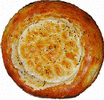 1 kg or 7 1/2 cups flour, 2 cups water, 2 teaspoons salt, 30 g (1 oz) yeast, 10 g (1/2 oz.) sesame and poppy seeds. 1 kg or 7 1/2 cups flour, 2 cups water, 2 teaspoons salt, 30 g (1 oz) yeast, 10 g (1/2 oz.) sesame and poppy seeds.
Recipe is identical to Obi-non above, except make the dough a little less stiff and allow to rise an extra 25-30 minuntes. Stamp patterns on top, scatter with sesame and poppy seeds, and bake in a tandoor oven.

Piyozli non - Flat bread with onions
1 kg or 7 1/2 cups flour, 30 g salt, 30 g (1 oz.) yeast, 60 g (2 oz.) dry milk, 40 g (1-2 oz) beef fat, 180 g onions, 14 g or 1 tablespoon vegetable oil, 20 g sesame seeds, 730 ml or 3 cups water.
Recipe is the same as Obi-non above. Stamp patterns on top and sprinkle with thinly sliced onions and sesame seeds. Allow to rise another 15-20 minutes under a pastry cloth and bake in a tandoor oven.

Shirmoi hon - Chickpea and anise flat bread
1 kg or 7 1/2 cups flour, 1L or 4 cups water, 1 cup chickpeas, 1 teaspoon anise seed, 2 teaspoons salt, 30 g (1 oz.) yeast.
Basic dough recipe is the same as Obi-non above. Pick and clean the best dried chickpeas and crush. Boil anise seed in water and then add crushed chickpeas. Cool for about an hour, add yeast and mix well. Add anise water to flour and make dough. Divid into pieces, flatten into round bread, 2.5 cm (1 in) at edges and 1 cm (2/5 in) in the center. Make a pattern in the center with chekish and make decorative pattern on sides bread with a knife. Bake in tandoor oven.

Lochira
1 kg or 7 1/2 cups flour, 2 cups water, 1 teaspoon salt, 30 g (1 oz) yeast, 1 cup grease
Make dough with warm salted water, yeast, grease, and stifted flour and let stand for 10-15 minutes. Divide dough into 200 g (7 oz) pieces and roll into balls. Flatten into round bread about 3-4 mm (1/6 in) thick. Make indentations on the top with chekish to reduce thickness of the edges and bake in a tandoor.

Yogli Lochira
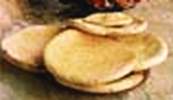 1.5 kg or 11 1/4 cups flour, 200 g (7 oz) margarine, 700 g or 3 cups milk, 13 g or 1 teaspoon oil, 20 g salt. 1.5 kg or 11 1/4 cups flour, 200 g (7 oz) margarine, 700 g or 3 cups milk, 13 g or 1 teaspoon oil, 20 g salt.
Dissolve salt in milk, add softened margarine and stifted flour and let stand for 30-40 minutes. Roll out dough into balls and let stand another 20-25 minutes. Flatten into round bread about 3-5 mm (1/8-3/16 in) thick. Make deep indentations on the top with a checkish to reduce thickness of the edges and bake in a tandoor.

Katlama - Flat bread
1 kg or 7 1/2 cups flour, 2 cups water, 1 1/2 cups grease or kaimak, 2 tablespoons sugar or confectioner's sugar, 2 teaspoons salt, 1 cup butter.
Add sifted flour to warm salted water. Knead dough and let stand 10-15 minutes. Roll out into a thin layer, 1 mm (1/25 in). Rub surface with grease, sour cream, or butter. Roll the dough around itself using a rolling stick (similar to a dowel). Cut lengthwise along the stick which 2 cm (3/4 in) strips. Roll up each strip, place in its side and flatten with a rolling pin to a thickness of 1 cm (2/5 in). Coat frying pan with melted butter and fry on both sides.

Piyozli katlama - Flat bread with onions
1 kg or 7 1/2 cups flour, 2 cups water, 1 cup kaimak, 3 onions, 1 cup butter, salt.
Add sifted flour to warm salted water. Knead dough and let stand 10-15 minutes. Roll out into a thin layer, 1 mm (1/25 in) and coat with kaimak. Sprinkle surface evenly wih chopped onions. Roll the dough with onions around itself using a rolling stick. Follow recipe for katlama above. Coat frying pan with melted butter and fry on both sides.

Gilmindi - Jizzax pancakes
1 kg or 7 1/2 cups flour, 2 cups water, 3 cups milk, 2 tablespoons sugar, 300 g (11 oz) butter, salt.
Make sauce by adding one cup flour to sweetened milk and cook until it thickens. To make dough, add water and salt to sifted flour. Allow to stand in warm place. Cut dough into 50 g (1-2 oz) pieces, roll out like flat bread and fry in butter. Coat top surface with milk sauce and fold into a half-moon.

Yupka - Pancakes
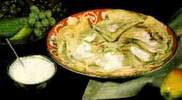 1 kg or 7 1/2 cups flour, 300 g (11 oz) mutton or beef, 2 onions, 1 tablespoon butter, salt, pepper, 250 g (9 oz) vegetable oil for frying. 1 kg or 7 1/2 cups flour, 300 g (11 oz) mutton or beef, 2 onions, 1 tablespoon butter, salt, pepper, 250 g (9 oz) vegetable oil for frying.
Mince the meat in meat-grinder and fry in oil. Make stiff dough out of flour, salt, and water, roll into tortilla-shaped breads but even thinner. Rub frying pan with butter and fry dough on both sides. Remove and fry second bread on one side. Flip over, spread out a thin layer of minced meat on the the side that has been fried. Layer with first bread and spread out another layer of filling and top with uncooked dough. Turn the entire stack over, repeat with filling and layers of dough. Make stack about 10-12 high. Cook on very low heat. To serve fold each layer with meat filling like an envelope.

Parmuda Samsa
1 kg or 7 1/2 cups flour, 1 1/2 cups water, 4 teaspoons salt, 50 g or 1/4 cup greese, 800 g (28 oz) meat, 500 g (18 oz) onions, 200 g (7 oz) animal fat, salt, spices to taste.
For the filling, put meat through a meat-grinder, combine well with choped onions and fat, salt and spices. To make stiff dough, add water and salt to sifted flour, let stand for 30-40 minutes. Roll out dough into thin layer, use mouth of a glass to cut out circles. Place a spoonful of filling in the center, pinch edges up around the filling forming a ball and completely enclosing the meat. Sprinkle the sides with water and join samsa together in a square. Coat top with beaten egg and bake 30-40 minutes in tandoor or oven.

Chip-Chip Samsa
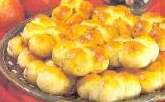 600 g or 4 1/2 cups flour, 4 eggs, 200 g or 4/5 cups water, 700 g (25 oz) meat, 800 g (28 oz) onions, 160 g (5-6 oz) mutton fat, salt, pepper and cumin to taste. 600 g or 4 1/2 cups flour, 4 eggs, 200 g or 4/5 cups water, 700 g (25 oz) meat, 800 g (28 oz) onions, 160 g (5-6 oz) mutton fat, salt, pepper and cumin to taste.
For the filling, combine finely diced (or minced) meat with chopped onions and fat, salt and spices. To make dough, add water, salt and egg to sifted flour, let stand for 30-40 minutes. Cut dough into 20 g (7/10 oz) pieces and roll out each piece into small flat rounds. Place a spoonful of filling (40 g or 1 1/2 oz) in the center, pinch edges up around the filling forming a ball and completely eclosing the meat. Join the sides of two samsa together and caot with beaten egg. Place on a greased pan and bake 25-30 minutes.

Tandir Samsa - Tandoori Somsa
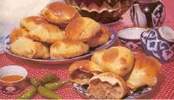 1 kg or 7 1/2 cups flour, 1 kg (2 1/4 lb) meat, 1 kg (2 1/4 lb) onions, 110 g (4 oz) mutton fat, salt and pepper to taste. 1 kg or 7 1/2 cups flour, 1 kg (2 1/4 lb) meat, 1 kg (2 1/4 lb) onions, 110 g (4 oz) mutton fat, salt and pepper to taste.
For the filling, put meat through a meat-grinder, combine well with chopped onions, cubed fat, salt and pepper. To make stiff dough, add water and salt to sifted flour, let stand for 30-40 minutes. Cut dough into 70 g (2 1/2 oz) pieces and roll out each piece into small flat rounds. Place a spoonful of filling in the center, pinch edges up around the filling, form an oval, and completely enclose the meat. Stick samsa to the walls of a tandoor and bake 25-30 minutes.

Varaki Samsa - Pastry Samsa
1 kg or 7 1/2 cups flour, 800 g (28 oz) meat, 500 g (18 oz) onions, 150 g (5 oz) mutton fat, 50 g (2 oz) butter, cumin, salt and pepper to taste.
For the filling, put meat through a meat- grinder, combine well with chopped onions, cubed fat, salt and spices. To make dough, add warm water and salt to sifted flour, let stand for 30-40 minutes. Roll out dough into 3-4 mm (1/8 in) layer and greese surface with melted butter. Roll up the dough tightly forming a log, and cool. Cut log into 70 g (2 1/5 oz) pieces and place on their flat sides. Roll out into small flat rounds. Place a spoonful of filling in the center, pinch edges around the filling forming oval pastry, and completely enclose the meat. Stick samsa to walls of tandoor, sprinkle water on top, and bake 20-30 minutes.

Kovoqli Varaki Somsa - Pumpkin Samsa
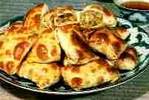 650 g or 4 3/4 cups flour, 400 g (14-15 oz) pumpkin, 2 egg, 160 g (3-4 oz) onions, 150 g (5 oz) mutton fat, 70 g (2 1/2 oz) margarine, sugar, salt and pepper to taste. 650 g or 4 3/4 cups flour, 400 g (14-15 oz) pumpkin, 2 egg, 160 g (3-4 oz) onions, 150 g (5 oz) mutton fat, 70 g (2 1/2 oz) margarine, sugar, salt and pepper to taste.
For the filling, combine diced pumpkin with chopped onions, fat, salt, sugar and spices. To make dough, add warm water, egg and salt to sifted flour, let stand for 30-40 minutes. Roll out dough into 3-4 mm (1/8 in) layer and grease surface with melted margarine. Roll up the dough tightly forming a log, and cool 5-6 hours. Cut log into 50 g (2 oz) pices and place on their flat sides. Roll out into small flat rounds. Place a spoonful of filling in the center, pinch edges around the pumpkin forming a square pastry, and completely enclose the filling. Bake 20-25 minutes in an oven.

Kuk Somsa - Samsa With Greens
1 kg or 7 1/2 cups flour, 2 cups water, 2 eggs, 60 g or 1/4 cup vegetable oil, 2 kg (4 1/2 lb) mixed greens (clover, mint, coriander, etc.), 100 g (3 oz) mutton fat, 2 bundles (6 oz) green onions, 4 onions, cumin, salt and pepper to taste.
For the filling, combine finely chopped greens with chopped onions, cubed fat, salt and spices. To make dough, add water and salt to sifted flour, let stand for 30-40 minutes. Cut dough into 50 g (1-2 oz) pieces and roll out each piece into small flat rounds. Place a spoonful of filling in the center, pinch edges closed around the filling, and form a ball. Bake 30-40 minutes.

Kartoshkali Kovurma Varaki Somsa - Fried Potato Pies
600 g or 4 1/2 cups flour, 500 g (18 oz) potatoes, 120 g (4-5 oz) onions, 120 g (4-5 oz) margarine, 100 g or 7 tablespoons vegetable oil, salt to taste.
For the filling, combine diced boiled potatoes with sauteed onions, salt and spices. To make dough, add warm water and salt to sifted flour, let stand for 30-40 minutes. Roll out dough into 1.5-3 mm (1/16-1/8 in) layer and grease surface with melted margarine. Roll the dough around itself using a rolling stick. Cut lengthwise along the stick which will result in several layers of strips of dough. Cut strips into appoximately 6x8 cm (2x3 in) squares. Place potato filling in the center of each square, fold in half, and pinch edges closed with your fingers. Deep-fat fry in hot oil.

Gumma - Fried Meat Pies
1 kg or 7 1/2 cups flour, 1 1/2 cups water, 2 eggs, 700 g (25 oz) meat, 50 g (2 oz) onion, salt and spices to taste.
Combine minced meat with chopped onions. To make dough, combine water, salt and sifted flour, let stand for 2-2 1/2 hours. Divide into 20-30 g (1 oz) pieces. Flatten and place minced meat in center. Fold into half moon, pinch the edges together lightly and deep-fat fry.

Balish - Baked Meat Pies
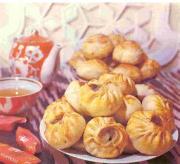 1 kg or 7 1/2 cups flour, 1 1/2 cup water, 1/2 cup oil, 30 g (1 oz) yeast, 1 kg (2 1/4 lb meat, 500 g (18 oz) onions, salt and spices to taste. 1 kg or 7 1/2 cups flour, 1 1/2 cup water, 1/2 cup oil, 30 g (1 oz) yeast, 1 kg (2 1/4 lb meat, 500 g (18 oz) onions, salt and spices to taste.
For the filling, combine finely diced (or minced) meat with chopped onions, salt and pepper. To make dough, combine water, oil, salt, sifted flour and yeast, let stand for 2-2 1/2 hours. Divide into 40-50 g (1/2-2 oz) balls. Roll out to a thickness of 3 mm (1/7 in) and place minced meat in the center. Fold dough up aroun filling, leaving a circular opening at the top. Place on greased pan, open side up, and let rise another 5-10 minutes. Coat with beaten egg and bake in pre-heated oven (200-240 C) for 8-10 minutes.
 |
http://www.uzbekcuisine.com/breads.html - http://www.uzbekcuisine.com/breads.html
------------- What a handsome figure of a dragon. No wonder I fall madly in love with the Alani Dragon now, the avatar, it's a gorgeous dragon picture.
|
Posted By: Snafu
Date Posted: 15-Mar-2012 at 04:39
One traditional dish of the Mongols for centuries has been Shulen, which is a hearty stew made with meat, roots, and wild vegetables. Buda'an, porridge made from millet, was also popular.
The Mongols also ate a type of meat jerky called borts. It lasted a long time and was the perfect kind of fast food for soldiers on campaign. It also allowed the Mongols to have meat during times when meat was scarce.
Grut, a type of very hard cheese, has also been popular among the Mongols for years.
|
Posted By: Don Quixote
Date Posted: 15-Mar-2012 at 13:49
The Old Bulgars, a tribe of whom came to the Balkans from Central Asia in 7th century AD, were nomads. They used to put horse milk in big bags made of skin with the hair inside, and carry it with them - so the mils turned in something like yogurt, but sligthly alcoholic, /because mare's milk has more sugars that sheep/goat one / called "kumis" http://en.wikipedia.org/wiki/Kumis - http://en.wikipedia.org/wiki/Kumis . Supposedly this was the base of making yogurt, that is a staple food in the Balkans now - but if the yogurt-making technology existed in the Mediterranean before the Old Bulgars came I have no idea. The Mongolian word for it -"airag" - is roughly the same like the Bulgarian "airan" /yogurt diluted with water, I put lots of black pepper in it/, and the Bulgarian word most probably came from the Mongolian one /it has only one linguistic step change "g" into "n", a lenition/.
-------------
|
Posted By: TheAlaniDragonRising
Date Posted: 15-Mar-2012 at 17:19
|
The Ossetian people were of the steppe, and they have an ancient recipe of an alcoholic drink called Arak.
| Arak is an alcoholic drink produced from corn grain, barley, or other grain crops. The history of Arak can be traced back thousands of years, although Ossetic traditions and behavioural norms did not approve of engaging into drunkenness, or inducing others. However, it does not mean that Ossets were total abstainers. On special occasions, weddings, funeral receptions and other traditional celebrations our ancestors enjoyed Arak and Ossetic beer, but did so with dignity and knowing their limit. Furthermore, Ossets never drank without reason, merely out of the desire to drink. Recently, in certain and particularly in southern regions of Ossetia, Arak has been distilled from sources other than grain, such as fruits. But nonetheless, original Arak resulted from grain, and in the given article we will concentrate on this technology. The taste and smell of Arak can be compared to Scottish whiskey, and certain types of the latter are very close to purified Arak of double distillation. This interesting fact in our opinion deserves the attention of historians, who study Alanian roots and their traces in Western Europe. Equally, I will be very glad if someone will take the opportunity to share an antique recipe of whiskey preparation.  |
Thus, how was Arak produced (distilled) by our grandmothers and grandfathers? They took approximately 10 – 20 kg (depending on the intended amount of the final product) of selected grain (zadag). The quality of grain for ferment determines the quality of the final product. The grain was then soaked in a large saucepan or a special pot and was set aside for three days. Following that period it was removed and spread out on an oilcloth or in a shallow trough in a layer of 5 to 7 cm thick and tightly covered with a blanket. If the layer is too thick, the grain might mould, if too thin, it will dry out. The grain must be allowed to sprout nicely, after which it is spread out in the sun to dry. Germinated and dried grain is then grinded and placed in a sack. The ‘working’ grain was also grinded and boiled to form a gruel-like substance known as kasha. Its amount should exceed that of the grain for ‘zadag’ by 3 or 4 times, and the quality of the grain may be lower. This grain was boiled in large cast pots in the proportion of 2 buckets of water to 2 buckets of flour. After the kasha cooled, some flour from zadag would be added (3 kg of zadag for 10 kg of ‘working’ flour) and mixed thoroughly. The kasha became more liquid in substance and after it cooled further it was poured into steel barrels. Next a bucket with kasha was separated and after yeast was added to it, it was evenly distributed across the barrels with kasha (arakag). The substance was mixed once more and the barrels were tightly closed with a lid or a dense material. Air must not seep inside. The ferment was left alone for a week, after which the distillation can begin. Nearly every household had special distilling equipment which consisted of a 50 litre cast-iron pot, a wooden cover and a 200 litre barrel with 2” copper tube penetrating the barrel. The ferment (arakag) was loaded into the pot, which was tightly closed with the cover with a pipe bend (see drawing). For a tighter seal the edges of the lid were also coated with kasha. The openpipe bend in the lid was also closely connected to the copper tube in the barrel, or a trough with cold water in the older times (see drawing). As soon as the fire was kindled underneath the pot, the ferment began to cook. The fire must be kept moderate, as to avoid the splattering of the ferment through the pipe bend. In the same time the water in the barrel must be kept in a cooled down state, for which usually one of the younger members of the household was placed in charge of stirring the water. In the more recent times a specially manufactured steel cooler with a hose connecting to the faucet replaced the barrel. After a certain period of time, the steam from the ferment, upon traveling through the tube, condensed into a liquid and trickled out of the opposite end of the pipe. A 10 litre glass vessel was situated underneath the tube, while over it was placed a filter consisting of a layer of clean medicinal cotton. It was replaced with a fresh one after every container of ferment. A full pot yielded on average 10 litres of Araka with 23 to 27% of alcohol. Notably, the first few streams are mush more concentrated than the succeeding ones. The last decades have witnessed the addition of sugar to the ferment for higher concentration. However, according to many testimonials this tactic results in headaches and overall unpleasant sensations fro those who consume the product. Equally, double distillation of Arak is not uncommon. In this case the pot is filled with already prepared Arak instead of the ferment and underwent distillation again. The quantity decreased, however the quality increased. The concentration of alcohol rose noticeably. |
http://ossetians.com/eng/news.php?newsid=557&f=34 - http://ossetians.com/eng/news.php?newsid=557&f=34
------------- What a handsome figure of a dragon. No wonder I fall madly in love with the Alani Dragon now, the avatar, it's a gorgeous dragon picture.
|
Posted By: Nick1986
Date Posted: 15-Mar-2012 at 19:59
Steppe people also made alcohol out of fermented mare's milk. This was the only way it could be drunk to avoid its laxative effects
-------------
Me Grimlock not nice Dino! Me bash brains!
|
Posted By: TheAlaniDragonRising
Date Posted: 15-Mar-2012 at 23:52
Originally posted by Nick1986
Steppe people also made alcohol out of fermented mare's milk. This was the only way it could be drunk to avoid its laxative effects
|
This was very much the main alcoholic drink for Mongolians until recent times, but unfortunately it's increasingly starting to take a back seat to vodka.
-------------
What a handsome figure of a dragon. No wonder I fall madly in love with the Alani Dragon now, the avatar, it's a gorgeous dragon picture.
|
Posted By: TheAlaniDragonRising
Date Posted: 16-Mar-2012 at 15:13
|
Here are a few Kazakh recipes.
| | Kespe (Noodles) a la Kazakh
Servings: 4
Ingredients:
30 g beef or mutton (brisket)
64 g vegetable oil
120 g onion
3 g garlic
1 g ground red pepper
240 g wheat flour
6 eggs
50 g water
1 g salt
Cooking Instructions:
Prepare thick dough and let it sit for 30 to 40 minutes. Roll out the dough into small sheets 1.5 mm thick, dry them a little, roll them up and slice them into thin strips (noodles). Cut meat into 23 mm cubes, fry in vegetable oil, add salt, pepper and bouillon and cook until done. Boil noodles, then serve them with meat, and sprinkle the mixture with greens. | Fish a la Irtysh
Servings: 4
Ingredients:
120 g fish (perch or sheat)
160 g potato
100 g fresh or pickled cucumber
60 g tomato
4 boiled eggs
80 g mayonnaise
Cooking Instructions:
Fillet the fish and fry it lightly on both sides. Then cool and slice it. Chop cucumbers and potatoes and mix with fish and mayonnaise. Arrange the salad in a pyramid and decorate with slices offish, tomatoes and eggs. Pour mayonnaise on top. | Kazakhstan Salad
Servings: 4
Ingredients:
96 g beef (shoulder) or 90 g mutton (ham or shoulder)
4 eggs
20 g milk
10 g butter or margarine
60 g potato
40 g pickled cucumber
40 g carrot
20 g canned peas
Cooking Instructions:
Slice boiled meat, potatoes, carrots and cucumbers; sprinkle with salt and pepper; mix it all together and add 40 g sour cream. Serve on a plate, decorating with peas, slices of meat and greens or pickled vegetables. | Pumpkin Samsa
Servings: 4
Ingredients:
300 g wheat flour
140 g water
2 g salt
400 g pumpkin
80 g fat of sheep's tail
100 g onion
10 g ground pepper
Cooking Instructions:
Cut pumpkin and fat into small cubes, add some chopped onion, salt and pepper, and mix everything. Bake for 25 to 30 minutes at a temperature of 200-220 degrees Centigrade. The pumpkin samsa can be served hot or cold. | Kuyrdak from Kazakhstan
Ingredients:
1 1/2 lbs beef
3 onion
2 tomato
1/4 cup vegetable oil
2 bay leaf
2 cups broth
1 1/2 teaspoons mixed spice
1 lb bread dough
For Sauce:
2 bunches spring onion
1 bunch fresh parsley, chopped
1/4 cup fresh basil, chopped
1/2 cup fresh dill, chopped
1 garlic clove, crushed
1/2 cup vegetable oil
1 cup yogurt
Cooking Instructions:
Cut meat into serving sized pieces and fry with chopped onions. Make balls with bread dough. Add broth, bread dough, spice mix, chopped tomatoes, and bay leaves. Bring to a boil, then stew about an hour or until tender. Meanwhile, fry garlic and spring onions until golden, then add all other sauce ingredients except yogurt and fry another minute or so. Set aside. When ready to serve Kuyrdak, add yogurt to sauce and stir well. Remove bay leaves, spoon meat onto a bed of rice and serve sauce on the side, as people will prefer different amounts. | Baursaks
Ingredients:
For dough:
3 pialas Flour
10 g Yeasts
0.6 piala Water
0.7 piala Milk
2 Eggs
30 g Margarine
1 t Salt
1 T Sugar
For frying:
1-2 pialas Oil
Cooking Instructions:
Adding all ingredients leavened dough is made. Of ready dough plaits are made which are cut in pieces 3- 3.5 cm each; they are left for 15-20 minutes, then fried in heated fat. | Beef Soup
Ingredients:
3 beef soup bones
2T olive oil
1 16 oz jar of sauerkraut, rinsed and drained
1 chopped onion
2 large baking potatoes, peeled and cubed
1 T hot chile sauce
Salt to taste
1/4 cup sour cream
Cooking Instructions:
Heat 1T oil in a large skillet, saute sauerkraut for a few minutes, then add enough water to cover, place lid on pan and simmer over low heat for 30 minutes. Drain and set aside. Heat remaining oil in a small skillet and saute onion until tender. Place soup bones in stock pot, cover them completely with water. Bring to boil and cook uncovered for about 1 hour. Remove bones to cool. Add potatoes and boil another 15 minutes. Stir in sauerkraut, onions and meat from bones. Season with chili sauce and salt to taste. Simmer at low heat for 15 minutes. Serve with dollop of sour cream.
Kazakh Rice
Ingredients:
1 ½ c Rice
⅓ c Slivered Almonds
2 Garlic cloves, minced
1 Med. Onion, chopped
½ c Dates, pitted, chopped
⅓ c Prunes, pitted, chopped
3 Dried Apricots, chopped
1 T Salt
1 c Lamb, finely ground, cooked
1 t Vegetable oil
Cooking Instructions:
Mix the lamb, almonds, fruits, onion, salt, and garlic in a large bowl. Cook the rice until almost done. Be sure to add the oil to the rice as it cooks. Do not drain! Add the lamb mixture and finish cooking the rice. Serve as a side dish or as main course. This is an easy dish that is a palate pleaser. | Gutap-Kazakh Fritters
Ingredients:
Filling:
3 tbl dill, fresh chopped fine
3 tbl parsley, fresh chopped fine
1 tbl minced garlic
9 tbl scallions, chopped fine
1 tbl black pepper, fresh ground
8 tbl butter
1 ½ tsp salt
Dough:
1 ½ cup all purpose flour
½ tsp salt
4 tbl butter, soft
2/3 cup warm water
Sauce:
1 tsp cider vinegar
1/4 cup sour cream
2 tbl butter
½ tsp flour
6 tbl finely minced onion
½ tsp salt
1 tsp black pepper, fresh ground
1 tbl lemon or lime juice
Cooking Instructions:
Dough: Place flour into deep mixing bowl, make hollow in center and add water, salt and 2 T of butter. Stir slowly until well mixed and water is total absorbed. Beat vigorously with a large spoon until firm, stiff dough is formed. Gather dough into a ball. Place ball on a floured surface and roll out into a rectangle (16"x18"). Brush dough with remaining butter, fold into quarters, then roll out as thin as possible. Cut into 2" squares, approximately 48.
Filling: Combine salt, pepper, scallions, garlic, parsley and dill. Cut the butter into tiny bits and chill until dough is ready. Please a teaspoon of filling mis into center of each dough square, add a piece of butter to each. Draw up corners and pinch firmly together to seal the filling into the dough. Heat oil in a deep pot to 375 degrees (F). Drop 4-6 filled squares in and cook for 4 minutes. Remove from oil, drain and serve warm.
Sauce: Melt butter, add onion, salt, pepper and vinegar. Cook for 4 minutes, add remaining ingredients (except lemon/lime juice) and continue cooking, stirring constantly until it thickens. Remove from heat, add lemon juice and serve over cooked fritters. | Kazahk Lamb Dumplings
Ingredients:
3/4 lb lamb, finely ground
2 tbl salt
1 egg
1 qt peanut oil
3 tbl butter
1/4 cup parsley, chopped fine
2 tbl cilantro, chopped fine
1 clove minced garlic
3 tbl cold boiled rice
Dough:
1 tsp salt
3 eggs
1 cup cold water
4 cups all purpose flour
Cooking Instructions:
Dough: Combine flour and salt in large mixing bowl , make well in center, add eggs and water. Mix with hands until thoroughly mixed. Gather dough into compact ball. Place ball on lightly floured surface and press flat. Knead dough by folding from end to end and flattening with the heel of your hand. Sprinkle dough with extra flour if needed. Knead for about 15 minutes or until dough is smooth and elastic in texture. Shape into ball, wrap loosely in waxed paper or place in a bowl covered with a towel. Allow to stand for 1-3 hours.
Filling: Melt butter in large skillet. Add 1 T of peanut oil and mix well over high heat. Add ground lamb and garlic. Brown well, breaking up any clumps that may form. Transfer to a mixing bowl, add parsley, cilantro, salt and rice. Mix thoroughly and allow to cool to room temperature.
Dumplings: Roll dough on a floured surface until approximately 1/8" thick then stretch until paper thin. Use cookie cutter or glass to cut into 3" circles (about 72). In center of each circle place 1 t of lamb filling. Fold circles in half, use a fork to press the edge of each dumpling and seal them. Lightly beat the egg, brush edges of seal of dumpling. Heat peanut oil in deep fryer until 375 degrees (F). Deep fry dumplings 2-3 minutes or until evenly browned. Drain well, serve over rice or with soup. | Salad “Shalgam”
Ingredients:
500 g Radishes
125 g Sweet Bullarian pepper
2 Carrots
1.5 Onions
50 g Dzhusai (a vegetable crop)
1 Garlic
75 g of seasoning for the salad
Cooking Instructions:
Salt and Spice to taste. Peeled radishes and carrots are cut in thin strips and rubbed with salt. Then sweet Bulzarian pepper, onions and garlic are cut, dzhusai is blanched. All vegetables are mixed, salted, peppered, the seasoning is added and the salad is decorated with slices of sweet Bulgarian pepper, radishes and greens.
Seasoning for the salad: 2 table- spoons of oil, 2 table-spoons of 3% vinegar, sugar, ground cayenne and salt to taste. Salt sugar and ground cayenne are mixed with vinegar, oil is poured in; all this is mixed and used to season the salad. | Sorpa with Rice
Ingredients:
600 g of Mutton
100 g of Fat of tail
1 Onion
0.5 piala Rice
4 T Katyk
2 T Dill
0.5 t Salt
2-3 Laurel leaves
Cooking Instructions:
Mutton is washed, cut in pieces 30- 45 g each; if there are bones they are chopped up. All this is put in a pan, covered with cold water; when boiling begins scum is removed and boiling is continued for 30-45 minutes. Then washed rice is added and boiled for about 30 minutes. At the end of boiling finely cut and slightly fried fat of tail, chopped onion, laurel leaves and salt are added. Serving the table one puts meat in soup-plates or kese, fills them with broth, adds katyk and strews all this with greens. | Salma
Ingredients:
For broth:
1 kg of Mutton or Beef with bones
2 Onions
Carrot
25 g of fat to fry Onions
salt, spice and greens to taste
For salma:
A piala of Flour
50 g of Water or Broth
2 eggs
A pinch of salt
Cooking Instructions:
Dough is made of flour, eggs and salted water, rolled thinly and cut in small squares about 20 cm each called salma. They are boiled in broth, then cut onion is added. Salma is seasoned with salt and laurel leaf. Being served it is strewed with greens. | Zhent the Kazakh Chocolate
Ingredients:
5 pialas of Millet
4 pialas of Irimshik
2 pialas of Sugar
3 T Raisins
Cooking Instructions:
2 pialas of Butter. Millet and irimshik are pound in a mortar. The mass obtained is mixed with sugar and raisins, butter is added and all this is cooled to thickening. The ready zhent is cut with a sharp heated knife. | Kazakh Tea (Chai)
Ingredients:
6 c water
6 tsp loose black tea
6 cardamon pods
1 ½ ts fennel seeds
3 cups milk
Sugar or honey to taste
Cooking Instructions:
Combine water, tea, cardamon and fennel seeds into large sauce pan and simmer over low heat for 3 minutes. Add milk and simmer addition 2 minutes. Strain tea into cups, add sugar or honey taste. | Samsa
Ingredients:
Filling:
6 oz Walnuts, shelled, crushed
1 1/2 tbsp Sugar
1 1/2 tbsp Butter, unsalted, softened
Dough 1 1/2 cup All purpose flour
1/2 tsp Salt
2/3 cup Lukewarm water
4 tbsp Butter, unsalted, softened
4 tbsp Confectioner's sugar
2 cup Vegetable oil
Cooking Instructions:
Filling: toss walnuts, butter, & sugar. Set aside at room temperature. Dough: put flour in a large mixing bowl. Make a well in the middle pour the water into the well, add salt, & ½ of the butter. Stir the flour into the flour mix slowly until absorbed. At this point, beat the mixture firmly until a good firm dough is made. Make the dough a ball. On floured surface, roll the ball out into a retangle approx. 18" x 16". Brush the dough with the remaining butter and fold into quarters. Roll it out again as thinnly as you can. Cut dough into a rectangle 18" x 16" then cut the dough into 2" squares. Place a teaspoon of walnut filling into the center of each square then draw up the 4 corners to the middle. Pinch the corners together to seal. Heat oil in a deep pot or a fry-well to 375 E F. Drop in 8-10 fritters at a time and fry them for 3 mins. Then remove to draining rack. Sprinkle with the confectioner"s sugar and serve. | Kazakh Pilaf
Ingredients:
600 g lamb
3 tb fat
4 ea onion
5 ea carrot
1 c dried apricots
1 c rice1
1/2 c water
Salt
Pepper
Cooking Instructions:
Slice onion and put it on the bottom of a well-heated cauldron and fry until light golden. Slice meat and fry with onion. Add juliienned carrot, salt, pepper and stew. Wash rice under running water and put evenly on meat layer (1 cup rice - 1 1/2 cup water). Bring to boil, making holes to let air get out. Put finely chopped dried apricots, cover and cook, not stirring, on low heat for an hour. Take off from the heat, cover warm and leave for 15 minutes. Stir carefully and serve on a large dish. | Kazakh lemon chicken
Ingredients:
1 tbsp Olive oil
2 ea Whole chickens (3-lbs ea)
2 tsp Ground ginger
1 tsp Paprika
3 ea Cloves garlic minced
1 ea Large onion chopped
1/4 tsp Saffron
1/2 tsp Nutmeg
2 tsp Salt
2 tbsp Black pepper Fresh grnd
2 cup Chicken stock
1 cup Green olives chopped
4 tbsp Lemon
Cooking Instructions:
Heat olive oil in a roasting pan and place chickens, breast down in the pan. Combine ginger, paprika, garlic, onion, saffrom, salt & pepper in a bowl. Rub this mixture onto the chickens and season to taste with add enough water to cover chickens halfway. Cook on high heat until boiling. Remove pan from heat and place in 400°F. Oven. Bake, uncovered, for 30 mins. Turn chickens & continue baking until tender & golden brown, approx. 25 mins. Move chickens to serving platter. Place pan on stove top & bring the chicken juices to a boil. Add olives and lemon rind. Reduce heat to low & simmer 5 minutes. Spoon sauce over chickens & serve. | Chrov plav
Ingredients:
1 cup Rice uncooked
1/4 cup Chopped almonds
2 tbsp Currants
2 tbsp Raisins
6 each Prunes dried, pitted, & coarsely chopped
3 tbsp Dates chopped
4 tbsp Butter
1/4 cup Apricots, dried, pitted & cut into strips ¼"x1"
1 tbsp Honey
2 cup Cold water
Cooking Instructions:
Soak, dates, currants, & prunes in a bowl of warm water for 15 minutes. Then remove them, pat dry, and mix with the other dried fruits. Mel the butter in a large, heavy skillet over high heat. Add the fruit mixture and the almonds. Reduce the heat to low and stir for 4 minutes, stir in the honey, rice, and water. Raise heat to high and bring to a boil. Reduce heat to low, cover and simmer for 25 minutes. Serve hot. | Sabzi piez
Ingredients:
3 tbsp Butter
1/2 tbsp Salt
1/4 tbsp Red pepper flakes
1/3 cup Chopped scallions
1 each Onion cut into thin rings
2 1/4 cup Carrots, Julienned
1 each Tomato, peeled, seeded chopped
1 tbsp Cider vinegar
tbsp Cilantro freshly chopped
Cooking Instructions:
Melt the butter in a large, heavy skillet over high heat. Fry the onion rings for 8 minutes, add the tomato, pepper, vinegar, & cilantro. Barely cover the carrots with water and bring to a boil. Reduce heat to simmer and do so for 10 minutes. Drain and add to the onion mixture. Sprinkle with the scallions and serve at once. |
|
-------------
What a handsome figure of a dragon. No wonder I fall madly in love with the Alani Dragon now, the avatar, it's a gorgeous dragon picture.
|
Posted By: Nick1986
Date Posted: 16-Mar-2012 at 19:20
The lamb dumplings sound good
-------------
Me Grimlock not nice Dino! Me bash brains!
|
Posted By: Nick1986
Date Posted: 17-Mar-2012 at 19:14
Was Tartare sauce invented by the Mongols?
-------------
Me Grimlock not nice Dino! Me bash brains!
|
Posted By: Nick1986
Date Posted: 18-Mar-2012 at 19:49
Got anymore recipes Alani?
-------------
Me Grimlock not nice Dino! Me bash brains!
|
Posted By: Nick1986
Date Posted: 21-Mar-2012 at 19:11
Steak Tatar was a French attempt to replicate the traditional Mongol dish. Unlike the real thing however, this modern imitation is served raw rather than dried
-------------
Me Grimlock not nice Dino! Me bash brains!
|
Posted By: TheAlaniDragonRising
Date Posted: 23-Mar-2012 at 09:05
|
This is a Tatar recipe.
Peremech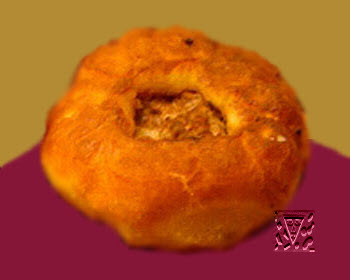
Recipe2 cups yogurt
water
3 1/2 tablespoons oil or butter
1/2 teaspoon salt
1/4 teaspoon sugar (I leave the sugar out, simply because I try not to eat too much sugar.)
2 eggs
4 1/2 to 5 cups flour (Wheat or white flour both work, although white flour is probably more common nowadays.) 2 large onions
1 1/2 cups chicken stock (I leave the stock out too, normally just because I don’t have any on hand.)
1 pound ground beef
1 teaspoon salt
pepper oil for cooking, about 1 cup (I’ve used regular vegetable oil, but I’m sure almost any cooking oil would work. Olive oil isn’t good for frying, and would give a weird flavor, so I don’t recommend it.) Combine 1/2 cup yogurt, 1/2 cup water, oil, salt, sugar and eggs in food processor or mixing bowl. Add enough flour to make workable, slightly stiff dough. Knead 7 to 8 minutes. Cover and let rest 1 hour. Peel and dice 1 onion. Put onion and chicken stock in saucepan and simmer until onion is soft. Set aside. (Because I wasn’t serving the peremechi with the broth, I completely skipped this step.) Peel remaining 1 onion and mince fine. Mix onion with ground beef, salt, pepper and 1/4 cup water. Divide dough into about 24 golfball-sized lumps. Roll each lump out to circle about 1/8-inch thick. Divide filling among dough circles. Place index finger of 1 hand in center of filling and use thumb, forefinger and middle finger of other hand to fold dough up to finger, and pinch together in tight pleats. (When peremech is finished, circular area under index finger will remain uncovered by dough.) Heat oil in frying pan and fry peremeches, 3 or 4 at time, placing them face down in oil until golden and then turning over to finish frying. Serve hot. To serve, spoon some onion and broth onto peremech, then 1 tablespoon yogurt. (I like to serve it just with some sour cream on top as well). This makes 24 pies. A serving is 2-3 pies.
|
-------------
What a handsome figure of a dragon. No wonder I fall madly in love with the Alani Dragon now, the avatar, it's a gorgeous dragon picture.
|
Posted By: Nick1986
Date Posted: 23-Mar-2012 at 20:59
Keep em coming Alani. I love reading this thread
-------------
Me Grimlock not nice Dino! Me bash brains!
|
Posted By: TheAlaniDragonRising
Date Posted: 24-Mar-2012 at 07:05
Originally posted by Nick1986
Keep em coming Alani. I love reading this thread
|
I have found a good supply of Tatar recipes, so I will post a number at a time.
-------------
What a handsome figure of a dragon. No wonder I fall madly in love with the Alani Dragon now, the avatar, it's a gorgeous dragon picture.
|
Posted By: TheAlaniDragonRising
Date Posted: 24-Mar-2012 at 07:08
|
Tatar recipes
Balesh(meat Pie)
Balesh prepare with the different filling it and mutton, beef, bird, fish, groats and vegetables (potato, carrot, cabbage et cetera), can be even fruit-baccate balesh.
Potato balesh with meat.
Fresh http://watan.su/en/kitchen/426-kamyr - dough is rolled by a skim; For filling there is the finely cut potato, fried on oil onions, finely chopped beef meat, salt, a pepper is prettily mixed. This filling is laid on geared-up dough (preliminary laid out on the frying pan smeared by oil) and cover the second layer stick both layers together inter se and beautifully adorning. From above smearing a vitellus put prepares in a gas-furnace. To the table give on a frying pan.
on 1 balesh: a 600-800 g of douth, 1,2 kg of potato, 500-600 g of meat, 200 g of onions, salt, pepper - to liking.
Baursak or Boortsoq
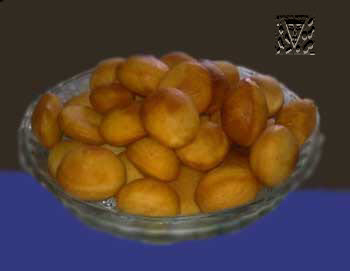
In ware to let out eggs, to pour milk, to add oil, granulated sugar, salt and yeast. The mix is good to the full dissolution of sugar, salt and yeast. Then to enter the sifted flour and knead http://watan.su/en/kitchen/426-kamyr - dough . It should be softer, than dough for house noodles. To take dough pieces on 100-150 g, to unroll their thin sausages and to cut slices in size about a wood nut. Slices to ship in boiling oil and, stirring slowly, to fry to a ruddy crust.
Ready boortsoq to decant in a colander, to allow to flow down to fat. Baursak moves on a table the cold. It is good to take it in road. On 1 kg of a flour: 10 pieces of eggs, 130-140 g milk, 30-35 g to sugar, 30 g melted butter, 5 g yeast, salt, oils for frying 180-200 Baursak with katyk. Prepare http://watan.su/en/kitchen/426-kamyr - yeasty dough , do balls in size about a walnut cut. Balls are fried in hot fan, then them take out from fat and cool. Balls put in bowl or a soup plate, fill in http://watan.su/en/kitchen/348-katyk - katyk and submit on a table. Baursak (dough with a liver) http://watan.su/en/kitchen/426-kamyr - Yeast dough is put. The liver (Baur in Tatar a liver), passed through a meat grinder and add to the dough. Ready dough unroll and cut balls in size about a walnut.
Ready balls fry in hot fan and submit on a table with http://watan.su/en/kitchen/348-katyk - katyk . On 600-650 g flour: 6-8 pieces of eggs, 150 g milk, 30 g to sugar, 30 g melted butter, 5 g yeast, salt, 400 g a boiled liver, for frying 200-250 г oils.
Bokkan 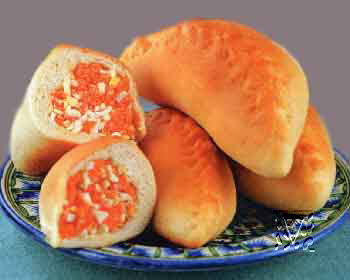
Bokkan the Tatar patties lunate. In the different districts of Tatarstan of them "taka" name also. Bokkan is characteristic for rural locality and prepares with the different filling. Most widespreaded carrot, cabbage, vegetable marrows and potato.
Bokkan with a carrot and egg
To wash down a carrot, clean, boil to mildness in the small amount of water (20-25 minutes), after to cool, finely to cut, mix up with sugar and leave on 10-15 minutes. To clean the boiled eggs from a shell, finely cut, mix up with a carrot, salt, pour the kindled desi and it is good to mix. To cut http://watan.su/en/kitchen/426-kamyr - dough on marbles weighing an about 90 g each, to roll in small cakes. On one half of every small cake to lay out filling an even layer, cover the second half, pinch together the edges denticles and to give of the bokkan
form of half moon.
To smear a roasting pan the small amount of oil, to lay out bokkans. To fluff up an egg, smear the surface of patties. To warm up an oven to 1800С and bake bokkans during 30 minutes, after to smear a desi and to serve up.
On one bokkan: a 90 g of test, 80-100 g of carrot, 1/4 eggs or a 20-30 g of the boiled rice, 15 g of oil, granulated sugar, salt.
Budene(Pudding) 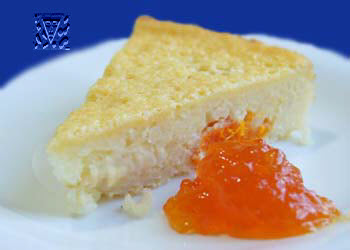
n deep tableware to pour milk, put 5 vitellus, salt, butter and all mass good to mix, add the boiled rice and again to mix. To beat up egg-white with the granulated sugar, pour in mass and all is careful to mix.
To smear a deep frying pan oil and cover a bottom a thin paper. To lay out the got mass, to make even a top, smear an egg, to sprinkle with the ground rusks and to put in an oven. When budene will rise and will accept a peach tint, he is ready.
To shift pudding from a frying pan to the hardboard or plate, carefully to separate from a paper, cut as blocks or rhombuses, sprinkle with castor sugar and hot to give to the table.
On a 1 portion: 200 g of milk, 5 eggs, 100 g of oil in pudding, 100 g of granulated sugar, 500 g of rice boiled, 50 g of oil to smear a frying pan, salt.
Chak-chak 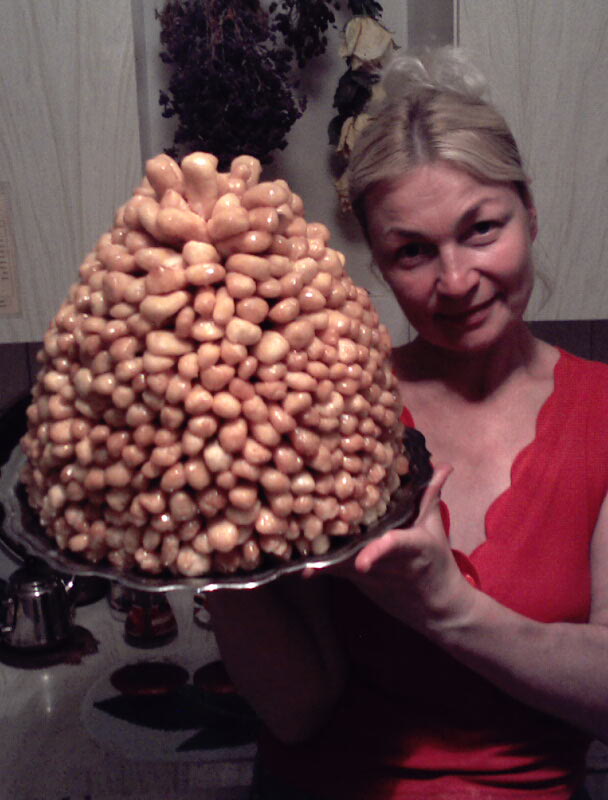
It is particularly popular in Tatarstan and Bashkortostan, and is recognized as Tatarstan's national sweet.
Chak-chak is made from unleavened dough cut and rolled into hazelnut-sized balls, which are then deep-fried in oil. Optionally hazelnuts or dried fruits are added to the mixture. The fried balls are stacked in a mound in a special mold and drenched with hot honey. After cooling and hardening, chak-chak may be optionally decorated with hazelnuts and dried fruits. On 1 kg of wheatflour : 10 eggs, 20-30 g of castor sugar, salt; 500-550 g of oil; 0,9-1 kg of honey, 150-200 g sugar; to adorn a 100-150 g of fruit drops.
Duchmak 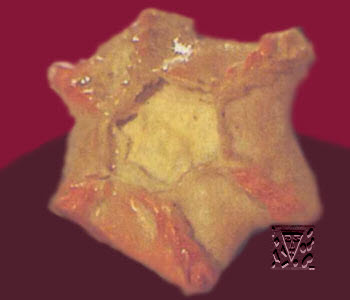
Duchmak with an egg
To divide the prepared unleavened http://watan.su/en/kitchen/426-kamyr - dough to pieces for 100 g and to roll small cakes by a diameter 15-17 sm. to Raise the edges of dough, to pinch together in 4-6 places so that a hexahedron turned out. To lay the got form on the dry heated frying pan and hold for some time in a hot stove, that slightly hardened. Then to shift duchmaks on the oiled frying pan or tin sheet, to pour on them the raw eggs stirred in milk and here to put in a stove. Prepared duchmaks to serve up, smearing oil.
on 1 duchmak: a 100 g of fresh dough, 2-3 eggs, 50 g of milk, 15 g of dairy butter.
Duchmak with a potato
To lot the prepared http://watan.su/en/kitchen/426-kamyr - Yeast dough weighing in 100 g and to roll small cakes. Raising edges, pinching dough in 4-6 places and on a dry frying pan to bake. Then by oil frying pan, to lay filling on a hardening small cake, oil a top an egg and put duchmaks baked until done in a stove or oven. Prepared duchmaks to smear oil and to give on a table.
If duchmak is made out of fresh dough, it is possible previously not to bake. Filling prepares, as well as for http://watan.su/en/kitchen/228-paramac - peremech with a potato.
on 1 duchmak: a 100 g of dough, 150-170 g of the prepared mashed potatoes, 1/4 eggs, 15 g of dairy butter
Gubadija 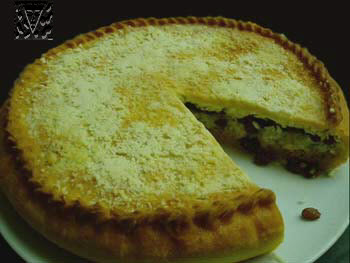
Usually gubadija prepare for guests. Gubadija is a large, round pie with the multi-layered filling. As filling add a http://watan.su/en/kitchen/341-qort - qort (tatar dry curd), boiled rice, fried onion with the chopped meat, finely cut egg, raisin/pl or dried apricots without stones or prunes. Every ingredient prepare separately.
Gubadija can be prepared as from unleavened so from yeast http://watan.su/en/kitchen/426-kamyr - dough with plenty of oil. Gubadija can be meat and fruit. In fruit gubadija meat is not added and give to tea. Meat gubadija is good to hot, she is given to clear soups.
Fruit gubadija
There is the rolled dough to lay on the preliminary oiled frying pan. Then add from above, at first skim of boiled rice, after more thick layer of http://watan.su/en/kitchen/341-qort - qort and again fig. by the Next layer the finely cut boiled eggs (4-5 mm) and again fig. Over rice proparasite raisin/pl or kuraga (dried apricots without bones or prunes). Abundantly pouring filling oil all of it is covered by the layer of test licking into the shape of pie adorning. We put in a stove and prepare approximately about 50.
On the frying pan of middle sizes : a 800 g of dough, 350-400 g of qort, 1-1,2 kg of boiled rice, 200-300 g of raisin/pl or other fruit, 8-10 eggs, 350-400 g of oil.
Kosh-tele(twiglets in tatar) 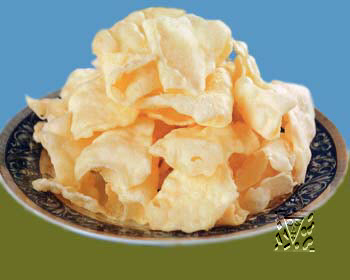
In a deep bowl to fluff up eggs with sugar, to infuse into milk, hardly to add some salt, add a soda, preliminary liquidating her lemon-juice. Carefully to mix sugars to dissolution. To sift Flour, thrash in a bowl and involve dough. On the table slightly sprinkled by a flour to roll dough in a layer in a 1-2 mm thick and to cut the figured knife rhombuses. In a frying pan it is good to warm up the melted butter, fry kosh-tele to the goldish color, after to shift on a dish. Prepared kosh-tele to cool, sprinkle with castor sugar and to serve up with tea.
on 5 eggs, 1 item spoon of the granulated sugar, 1/4 glasses of milk, salt, 1/4 teaspoons of soda, 1/2 items of spoon of lemon-juice, half kg of white flour, 1 glass of the drowned oil, 3 items of spoon of castor sugar.
Kystybyj 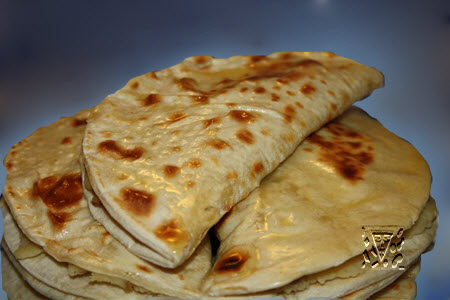
In some places kystybyj name kuzikmak or jakmysh. Usually he is prepared from a http://watan.su/en/kitchen/426-kamyr - unleavened dough . Filling can be different, mostly it is a potato, rarer than porridge or poppy.
Kystybyj with a potato
To cut unleavened http://watan.su/en/kitchen/426-kamyr - dough to pieces for 75 g, to roll on thin small cakes and bake on a burning hot dry frying pan to the rosy crust. To cover the prepared small cakes a napkin, that they did not harden and did not get cold.
Filling is made out of the mashed potatoes with hot milk, kindled by oil and passed onions.
Filling is laid on a half yet hotter than small cake and cover the second half. Smearing prepared kystybyj the drowned oil give in a hot kind to tea.
On 1 kystybyj: a 75 g of unleavened dough, 100 g of potato, 20 g of onion, 20 g of milk, oil for greasing of kystybyj 20 g
Kystybyj with a poppy
To sift a poppy and soak in hot water. To cast aside a dropsical poppy on a sieve and, giving to flow to water, to pound in a mortar. Then to add a bit sour cream and saccharine to sand. To inlay the got mass in arcuated twice small cakes.
On 1 kystybyj: a 75 g of unleavened dough, 80-100 g of poppy, 20 g of oil, 20 g of sour cream, 20 g of sugar.
Ochpochmak 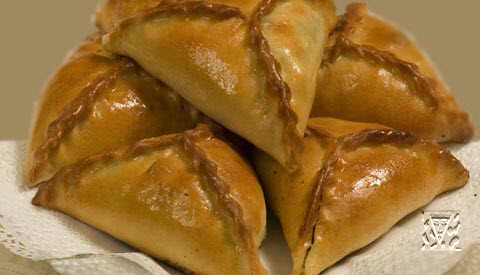
Ochpochmak is a Tatar national dish, an essential food in Tatar culture. Usually, öçpoçmaq is a triangular pastry, filled with minced beef, onion and potatoes.
Unleavened or leavened dough is rolled in small cakes by a size with tea saucer. On small cakes lay the prepared filling, the edges of dough raise from three parties nip, abandoning in the middle opening and giving shape to good triangle.
For filling fat meat and potato cut shallow blocks and mix up with the finely chopped onions, oil, pepper and salt. Filling it is necessary to prepare not all at once, by small portions. Triangles oil by yolks with milk, put in the heated broiler, in a half hour take out, infuse into through opening clear soup and continue to be stove. Before serving up in ochpochmaks infuse into clear soup and top smear with oil. Ochpochmaks is eaten with bouillon or with tea.
On 1 kg of dough : a 600-650 g of flour, 20-25 g of yeasts, 30 g of sugar, 1-1,5 eggs, 50-60 g of margarine, 100-120 g of milk, 150-200 g of water, 10-20 g of salt.
On one ochpochmak: a 60-70 g of potato, 30-35 g of burnt onion, 10-25 g of the melted butter, salt, pepper. 50 g finely carved.
Samosa 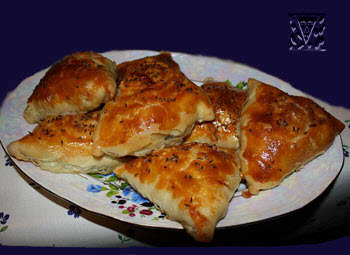
Samosa prepare from http://watan.su/en/kitchen/426-kamyr - unleavened dough , filling can be meat, fish, vegetable, baccate or egg. Samosa with meat For samosa a beef or veal befits well, in the Uzbek kitchen more frequent use mutton. You will twist a bow and meat on a meat grinder. Then will salt and pepper the turning out stuffing. Dough will divide into pieces for 50 gs roll, will lay out filling on a middle and wrap up the edges of dough in form triangles. Smear a roasting pan sunflower-seed oil and will lay out samosa in the distance one from another. Smear the surface of samosa the fluffed up egg and bake in an oven warmed-up to 200 degrees during 25 minutes. On one samosa: a 50 g of dough, 35 g of the chopped meat, 6 g of oil, bow, pepper, salt, for greasing egg. Samosa with an egg Usually such samosa prepare adding rice. Cleared and washed rice steep in the salted water, scald and skip through a sieve. A bit cooling add the finely cut boiled egg and mix. Further we prepare triangles as well as for samosa with meat and bake. On one samosa: a 50 g of unleavened dough, 25 g of rice, 1/3 eggs, 6 g of oil, pepper, salt to taste
Shanga 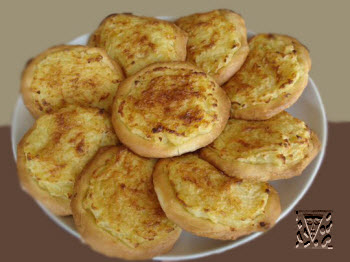
Shanga is a very ancient dish. It was widespread in regions, by the inhabited people of Finno-Ugric group from Karelia to Ob. To date has widespread in the domestic kitchen of Ural and among Siberian Tatars. Shanga with a potato. From http://watan.su/en/kitchen/426-kamyr - Yeast dough do marbles mass an about 70 g, lay on folias, smeared by oil, give to stand in a heat a few minutes, do deepening and lay filling on him, oil by egg and bake. For filling the boiled potato is pounded, adding hot milk with eggs and sour cream, mix well. Composition: dough - flour wheat 40, sugar 3, oil 3, egg 1/20 th, milk 10, salt, yeasts. filling - potato 60, milk 10, egg 1/10 th, sour cream 8, bow 10, oil 2. Siberian shanga http://watan.su/en/kitchen/426-kamyr - Yeast dough is divided to pieces by mass of a 60-70 g, roll them in round small cakes by a diameter a 7-8 sm, lay on folias, smeared by oil, give to stand in a heat a few minutes. The sour cream filling is oil from above small cakes and bake to readiness in an oven. Composition: yeast dough - 1 kg, filling - flour 1/2 glasses, egg of 1 th, sour cream 1/2 glasses, vegetable oil 2/3 glasses, salt and pepper to liking.
Vak Balesh 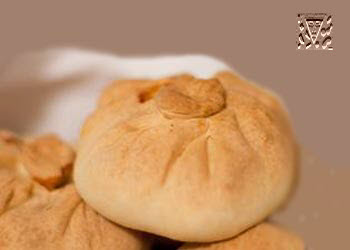
Vak balesh in translation small pie, bakes on the frying pan smeared by oil in an oven or stove. http://watan.su/en/kitchen/426-kamyr - dough can be taken leavened or unleavened. Filling is made out of different groats (rice, buckwheat, oatmeal, millet) with addition of mutton, beef, byproducts or meat of bird (goose, duck). Vak balesh give on the second.
Vak balesh on bouillon Knead http://watan.su/en/kitchen/426-kamyr - unleavened dough and prepare filling as for http://watan.su/en/kitchen/65-ochpochmag - ochpochmak . Roll dough on small cakes a diameter 15 cm, on a middle lay out filling. Pinch together the edges of small cake. In the middle leave opening in a 4 cm, which is closed by the skim of dough.
Balesh lay out on the oiled frying pan, smear a raw egg and put in the stove of minutes on 15-20. Browned balesh take out and opening hole, pour a bit bouillon in each. Obturate and lay in a stove yet minutes on 30-40. To the table to give again adding bouillon to every balesh. On one balesh: a 150-180 g of unleavened dough, 150 g of meat, 160-180 g of potato, 40 g of onions, 3/4 glasses of bouillon, egg 1/4
Vak balesh offhand For filling to boil rice and cast aside on a sieve. To fry the finely shredded onions to the goldish color. To grind mutton pulp and to fry. To mix up the fried stuffing with rice and onions, add salt, pepper, melted butter.
Vak balesh is baked very quickly in an oven, during 20-25 minutes.
-------------
What a handsome figure of a dragon. No wonder I fall madly in love with the Alani Dragon now, the avatar, it's a gorgeous dragon picture.
|
Posted By: Don Quixote
Date Posted: 24-Mar-2012 at 10:48
In the recipe "boursak with katyk" - I found this interesting - "katyk" is a dialectic Bulgarian word for "filling", or something that one puts on a slice of bread, like butter or jam. I suppose the word came with the Old Bulgarians, just like "airan". Now in Bulgaria is fashionable to say that the Old Bulgarians weren't Central Asian, but an Iranian tribe - but AFAIK the linguistic connections they have are with Central Asians.
-------------
|
Posted By: Nick1986
Date Posted: 24-Mar-2012 at 19:20
Originally posted by Don Quixote
In the recipe "boursak with katyk" - I found this interesting - "katyk" is a dialectic Bulgarian word for "filling", or something that one puts on a slice of bread, like butter or jam. I suppose the word came with the Old Bulgarians, just like "airan". Now in Bulgaria is fashionable to say that the Old Bulgarians weren't Central Asian, but an Iranian tribe - but AFAIK the linguistic connections they have are with Central Asians.
|
Perhaps they were a mixture of the two: Iranian settlers may have come first, then intermixed with the invading steppe people
-------------
Me Grimlock not nice Dino! Me bash brains!
|
Posted By: TheAlaniDragonRising
Date Posted: 24-Mar-2012 at 20:02
Originally posted by Nick1986
Perhaps they were a mixture of the two: Iranian settlers may have come first, then intermixed with the invading steppe people
|
Well there were groups considered to be central Asian and Iranian, and within these were Scythians, Sarmatians, and Alani(Often classed as Sarmatians).
-------------
What a handsome figure of a dragon. No wonder I fall madly in love with the Alani Dragon now, the avatar, it's a gorgeous dragon picture.
|
Posted By: TheAlaniDragonRising
Date Posted: 09-Aug-2012 at 00:07
|
I've just found the Tatar recipes once again, so here are a few more:
Tatar Soup Recipes:
Chumar (trickled pastries)
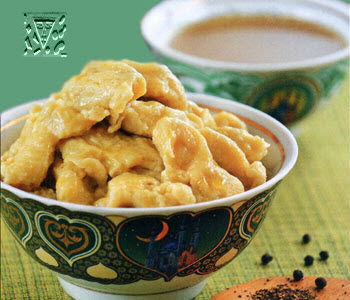
To cook meat-stock (better from mutton, beef or hen). Pass through a filter him, to pour off part for preparation of http://rinfom.com/kitchen/94-kamyr - dough , to use remaining http://rinfom.com/kitchen/102-shulpa - clear soup for cooking of soup.
For preparation of trickled pastries to pour the sifted flour in tableware, in the middle to do deepening, add an egg to him, put salt and, little by little refilling clear soup, to knead dough. Clear soup for chumar must be not hot, an egg can coagulate otherwise. http://rinfom.com/kitchen/94-kamyr - dough must turn out liquid (as thick sour cream) enough, well mixed to homogeneous mass, that did not flow down from a spoon.
From the prepared dough to take small pieces by a size with hazel-nut and to lay them in the boiling added some salt and pepper clear soup or soup.
To cook chumar to readiness (12-15 minutes), after to lay out on piattis and serve up. http://rinfom.com/kitchen/102-shulpa - clear soup is given in separate tableware.
Trickled pastries can be made out of wheat, peas, buckwheat and lentil flour.
Flour - 35-40 g, eggs are 1,5 th., water or clear soup - a 30-40 g, salt, pepper to liking.
Okroshka In Tatar
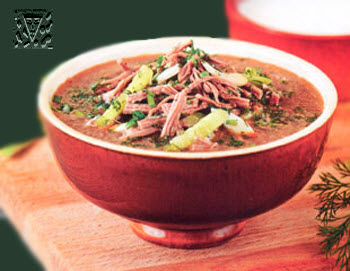
At first prepare grain kvass. Then a boiled egg yolk pound with ready mustard and granulated sugar. Add this mix in kvass and well having mixed, put for some time in a cold place. Small chop green onions and rub with salt. Boiled cold meat, a fresh cucumber and boiled egg cut long strips (by noodles). All products put in cold kvass and well having mixed, having added salts put for 30 minutes in a cold place. Pour ready okroshka in the portions and having strewed small cut fennel submit to a table. Separately to okroshka submit http://rinfom.com/kitchen/130-katyk - katyk or sour cream. To cold soups at will it is possible to submit food ice. For one portion: 300-350 g kvass, 80-100 g boiled meat, 50 g green onions, 50 g fresh cucumbers, 1 egg, 100 g katyk, salt, granulated sugar and the rest to taste.
Oyre
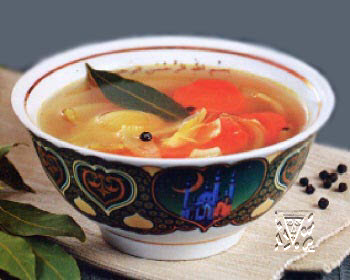
Oyre (soups of groats) : wheat, rice, buckwheat, avenaceous et cetera. Except groats, in soup it is possible to put a potato, bow, carrot and other vegetables then oyre will be more thick and saturated. Oyre cook in cast-iron, in a stove, but it is possible to cook and in an ordinary pan on a fire. When ojre prepares in cast-iron, all foods are mortgaged simultaneously and inundated by water. To this time to be stove must be melted, coals and ash it is necessary to rake out, cast-iron densely to close a lid and to put in a stove.
Oyre with buckwheat
In filtering meat-stock for preparation lay the well washed buckwheat groats, when will begin to boil, add the large cut potato and by groups carrot, onions warmed-up melted butter shredded by rings. To liking lay salt, pepper, at the end of cooking is a laurel sheet. Taken to readiness. At a serve the piece of meat is laid in every dish, buckwheat oyre is sprinkled with greenery.
That soups, prepared with groats, did not become cloudy, groats can be boiled separately and in the end to connect with other foods.
On one portion: meat by a bone-in - a 100 g, bulb onion - 20 g, carrot - 20 g, potato - 100 g, groats buckwheat - 60 g, oil melted - 10 g, salt, pepper, laurel sheet. Salma
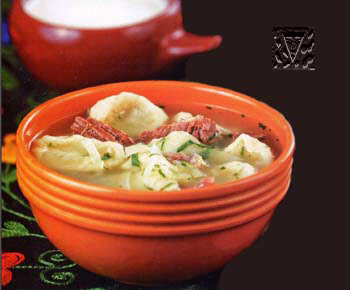
Salma is flour dish as cockleshells, a very widespread among Tatars. He is prepared on meat-broth and on decoctions. Salma can be cooked with a potato, bow, carrot, peas, lentil. Salma, cooked on decoction, refuel a bow, toasted on oil. Usually salma eat with http://rinfom.com/kitchen/130-katyk - katyk .
Salma make out of wheat, buckwheat, lentil or peas flour. In a cup or on a hardboard to put flour, add eggs, put to liking salt and, pour the cooled clear soup, to knead http://rinfom.com/kitchen/94-kamyr - dough , as for a noodle. To cut the prepared dough to pieces for 100 g. and to roll him in plaits in a no more than 1 sm thick, to cut ball and to lick into to them the shape of "cockleshells", pressing down a thumb the middle of every ball.
Soup from mutton with salma
To wash mutton, cut, put in a pan, fill water and to put on a fire. To put salt after 15-20 min till meat will weld. To take out the prepared meat, filter clear soup and again put on a fire. To put cut by groups carrot and bow, after - a potato. Before a potato will weld, to put salma and cook, while she will not rise to the surface.
Meat by a bone-in - a 150 g, carrot - 15 g, bulb onion - 15 g, potato - 100 g, salma ready - a 40 g, melted butter - 10 g, salt, pepper. Shulpa (broth)
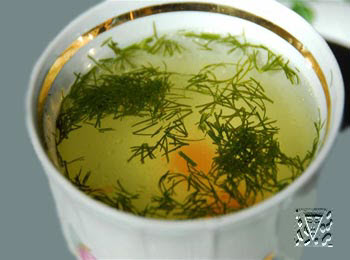
A considerable place in the Tatar kitchen occupies shulpa (broth). Shulpa season with onions, carrot, parsley, pepper, laurel sheet, and she is meat, fish, vegetable and mushroom.
Shulpa meat. To wash meat, not pressing out juices, to cut to pieces weighing 300-350. After to put in a pan, add cold water, to cover a lid and to put on a fire. Warming to regulate so that there was not the stormy boiling, otherwise shulpa will become turbid. Scum, appearing at boiling, it is needed from time to time remove, otherwise she will settle on a bottom and her it will be difficult to separate from shulpa. If scum already had time to settle, it is needed to add cold water to broth, and she will emerge. After the removal of scum, shulpa is necessary to give again to begin to boil. If meat for preparation of shulpa was fat, part of fat, floating in on a surface, is needed to take off and use for toasting of onion.
Salt in broth is added for 20-30 minutes to the end of cooking.
Meat usually is boiling 1,5-2 hours. To lay out the prepared meat in separate tableware, and filter shulpa through a colander or clean gauze. Meat can be used for the second dishes.
Meat shulpa is possible to cook with a carrot, parsley (by a root), turnip and onions. Greenery and vegetables (whole or bisected) are laid only after the removal of scum. When they will weld, them is necessary to take out from shulpa.
Meat shulpa is used for preparation of different soups - with groats, noodle, vegetables, and also for meat dumplings.
On 1 kg of meat : a 1,5-2,0 litre of water ( depending on the capacity of tableware). 15 g of onions, 15 g of carrot and 12 g of root of parsley.
Shulpa bone. For preparation of bone shulpa is possible to take tubular and flat bones: humerus, shins, thigh-bone and other.
To dissociate meat from bones (to use flesh for preparation of other dishes).
To cut the washed bones, put in a pan, inundate cold water and to put on a strong fire.
When water will begin to boil, to reduce a fire. Bone shulpa is boiling 2,5-3 hours. 20-30 minutes prior to a complete to put salt, carrot, parsley, onions, laurel sheet. Prepared shulpa to filter.
On 1 kg of bones : a 1,5-2,0 litre of water, 15 g of onions, 15 g of carrot and 12 g of root of parsley.
Shulpa chicken. To put a geared-up hen in a pan and inundate cold water. On a strong fire to take to boiling, to take off scum, and to reduce a fire and cook about 1 hour. Then to put a carrot and onions in broth, add salt. To take out the boiled hen from broth. To delete a carrot and onions. Prepared shulpa to filter.
on 1 kg of hen : 1,5 л of water, 1 carrot, 1 head of onions, salt to liking.
Tatar Solyanka
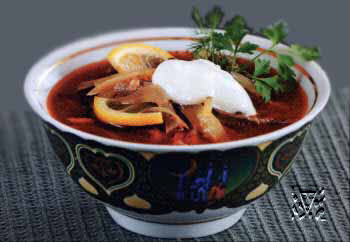
To soak prunes in hot water on 20-30 minutes, after to wring out and cut strips. To shred meat and byproducts a thin straw. To clean cucumbers from a skin and seed, cut bars. To clean bow, cut thin semirings.
In a frying pan to warm up a dairy butter, brown on him bow and cucumbers to mildness (7-8 minutes). To divorce tomato paste the small amount of clear soup, to add to the frying pan and stew vegetables yet about 3-4 minutes.
In a pan to infuse into clear soup, put meat, byproducts, vegetables and prunes, salt, pepper to liking. To take soup to boiling and cook on a middle fire during 10-15 minutes.
At a serve to add the spoon of sour cream or katyk and slice of lemon to every dish.
Composition: a 200 g of prunes without stones, 200 g of the boiled beef, mutton or horseflesh, 100 g of the boiled beef buds or language, 4 middle salt cucumber, 3 middle bulbs, 1-2 tablespoon of dairy butter, 3 tablespoon of tomato paste, 2 litr of meat-stock, salt, ground black pepper, 8 tablespoon of sour cream or katyk, 8 slices of lemon
Tockmach
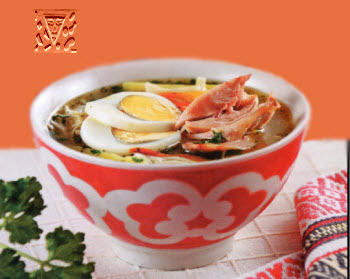
Tockmach do on clear soup from a beef, mutton, hen or turkey. He can be prepared with a potato or without a potato.
To wash down a potato, bow and carrot and clean. To cut a potato shallow bars. To cut bow and carrot a straw and to brown on vegetable oil. Clear soup to infuse into in a pan, take to boiling, put a potato, add some salt and cook during 10-15 minutes on a middle fire, after to add brown vegetables. In a separate pan to boil the added some salt water, put a noodle and cook 2-3 minutes, after to cast aside on a colander, give to water to flow. To add a noodle to soup and boil thoroughly during 5-7 minutes after boil. To cut chicken meat small slices, to lay out on drinking bowls, inundate soup, pepper to liking and to serve a dish up hot, sprinkling with greenery.
In prepared tockmach possible to add the pieces of the boiled egg.
Composition: 3-4 large potatoes, 2 middle bulbs, 1 middle carrot, 1 tablespoon of vegetable oil, 2 l of chicken clear soup, salt, 150 g of domestic noodle, 150 g of the boiled hen, ground black pepper, parsley, dill.
-------------
What a handsome figure of a dragon. No wonder I fall madly in love with the Alani Dragon now, the avatar, it's a gorgeous dragon picture.
|
Posted By: Nick1986
Date Posted: 09-Aug-2012 at 19:10
I tried sour rye soup in Poland. Perhaps this was also derived from Tatar cuisine?
-------------
Me Grimlock not nice Dino! Me bash brains!
|
Posted By: heyamigos
Date Posted: 31-Aug-2012 at 04:42
|
I don't consider Uygurs to be steppe cuisine because they are a very sedentary people with long history. But, of all the Turkic people's food, I got to admit the Chinese would feel more comfortable with Uygurs. Their noodles 'laman' (soup based or pan fried) tastes very similar to how we make it, but of course they also have their own native special sauce/spices. Their palao (pilaf?) is also sort of a combination between Persian variety and Chinese "fried rice". Very good and tasty too.
|
Posted By: Guests
Date Posted: 04-Jan-2013 at 00:13
|
So as for mongolian cuisine um I am Mongolian myself so it's mainly meat cooked in different ways they are either roasted and we eat a lot of goat ans sheep and beef we also eat the head and they are not cooked in like a kitchen and all those nice things it's outside in the nature and we use a knife to just cut pieces of meat off and eat it we also have khuushur and buzz which is a type of steamed and fried dumplings with meat and during the summer and spring we have milk products like dried curds and airbag which is horse milk etc we do a lot of herding and moving so I guess a little bit of cholesterol never really hurts
|
Posted By: Centrix Vigilis
Date Posted: 04-Jan-2013 at 03:19
Originally posted by Nelly
So as for mongolian cuisine um I am Mongolian myself so it's mainly meat cooked in different ways they are either roasted and we eat a lot of goat ans sheep and beef we also eat the head and they are not cooked in like a kitchen and all those nice things it's outside in the nature and we use a knife to just cut pieces of meat off and eat it we also have khuushuur and buzz which is a type of steamed and fried dumplings with meat and during the summer and spring we have milk products like dried curds and airbag which is horse milk etc we do a lot of herding and moving so I guess a little bit of cholesterol never really hurts |
Sounds delightful. I would eat well in Mongolia. Sounds very much like the American Indian of the 19th ce. diet; altho they were not big on milk perse. How about fruits and berries, wild vegetables etc.? what are yours?
-------------
"Absence of evidence is not evidence of absence"
S. T. Friedman
Pilger's law: 'If it's been officially denied, then it's probably true'
|
Posted By: Guests
Date Posted: 07-Jan-2013 at 13:18
|
Well in a country that reaches up to -40 C you wouldn't expect many fruits to be wild just imported but some berries can be picked at some point and we have really tiny wild strawberries as for vegetables we not grow the in the spring time and during the winter more imports
|
|











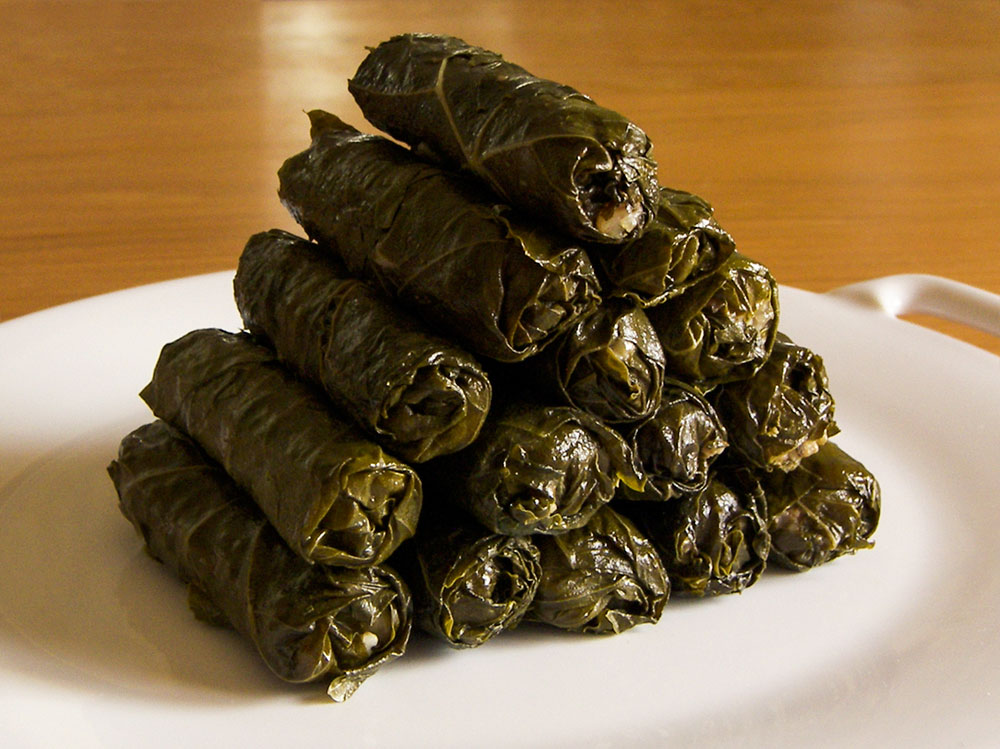









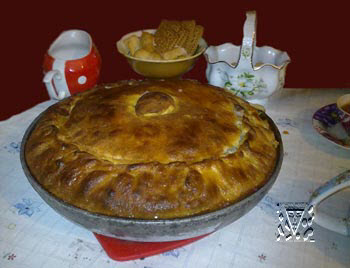




 1 kg or 7 1/2 cups flour, 30 g (1 oz) yeast, 1-2 cups milk, 3 tablespoons oil, salt.
1 kg or 7 1/2 cups flour, 30 g (1 oz) yeast, 1-2 cups milk, 3 tablespoons oil, salt.
 1 kg or 7 1/2 cups flour, 2 cups water, 2 teaspoons salt, 30 g (1 oz) yeast, 10 g (1/2 oz.) sesame and poppy seeds.
1 kg or 7 1/2 cups flour, 2 cups water, 2 teaspoons salt, 30 g (1 oz) yeast, 10 g (1/2 oz.) sesame and poppy seeds. 1.5 kg or 11 1/4 cups flour, 200 g (7 oz) margarine, 700 g or 3 cups milk, 13 g or 1 teaspoon oil, 20 g salt.
1.5 kg or 11 1/4 cups flour, 200 g (7 oz) margarine, 700 g or 3 cups milk, 13 g or 1 teaspoon oil, 20 g salt. 1 kg or 7 1/2 cups flour, 300 g (11 oz) mutton or beef, 2 onions, 1 tablespoon butter, salt, pepper, 250 g (9 oz) vegetable oil for frying.
1 kg or 7 1/2 cups flour, 300 g (11 oz) mutton or beef, 2 onions, 1 tablespoon butter, salt, pepper, 250 g (9 oz) vegetable oil for frying. 600 g or 4 1/2 cups flour, 4 eggs, 200 g or 4/5 cups water, 700 g (25 oz) meat, 800 g (28 oz) onions, 160 g (5-6 oz) mutton fat, salt, pepper and cumin to taste.
600 g or 4 1/2 cups flour, 4 eggs, 200 g or 4/5 cups water, 700 g (25 oz) meat, 800 g (28 oz) onions, 160 g (5-6 oz) mutton fat, salt, pepper and cumin to taste. 1 kg or 7 1/2 cups flour, 1 kg (2 1/4 lb) meat, 1 kg (2 1/4 lb) onions, 110 g (4 oz) mutton fat, salt and pepper to taste.
1 kg or 7 1/2 cups flour, 1 kg (2 1/4 lb) meat, 1 kg (2 1/4 lb) onions, 110 g (4 oz) mutton fat, salt and pepper to taste. 650 g or 4 3/4 cups flour, 400 g (14-15 oz) pumpkin, 2 egg, 160 g (3-4 oz) onions, 150 g (5 oz) mutton fat, 70 g (2 1/2 oz) margarine, sugar, salt and pepper to taste.
650 g or 4 3/4 cups flour, 400 g (14-15 oz) pumpkin, 2 egg, 160 g (3-4 oz) onions, 150 g (5 oz) mutton fat, 70 g (2 1/2 oz) margarine, sugar, salt and pepper to taste. 1 kg or 7 1/2 cups flour, 1 1/2 cup water, 1/2 cup oil, 30 g (1 oz) yeast, 1 kg (2 1/4 lb meat, 500 g (18 oz) onions, salt and spices to taste.
1 kg or 7 1/2 cups flour, 1 1/2 cup water, 1/2 cup oil, 30 g (1 oz) yeast, 1 kg (2 1/4 lb meat, 500 g (18 oz) onions, salt and spices to taste.















